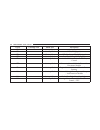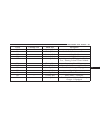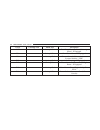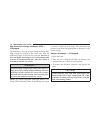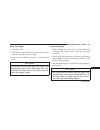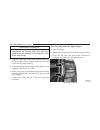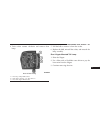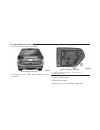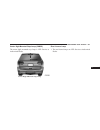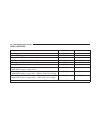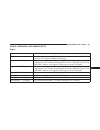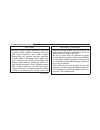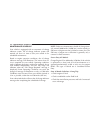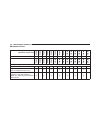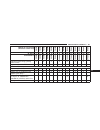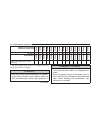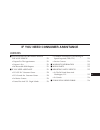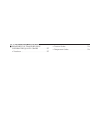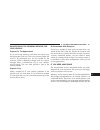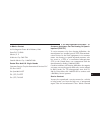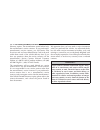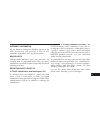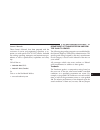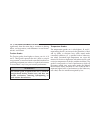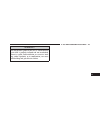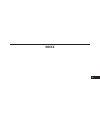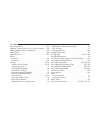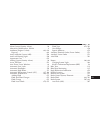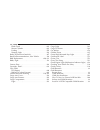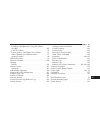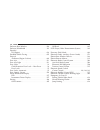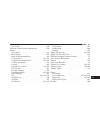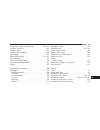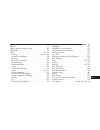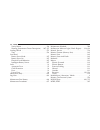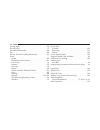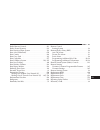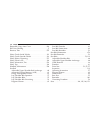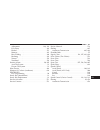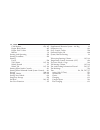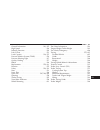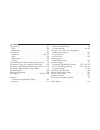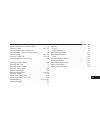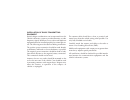- DL manuals
- Jeep
- Automobile
- Gand Sherokee 2016
- Owner's Manual
Jeep Gand Sherokee 2016 Owner's Manual
Summary of Gand Sherokee 2016
Page 1
Grand cherokee o w n e r ’ s m a n u a l 20 16 gr and cher ok ee second edition printed in u.S.A. 16wk741-126-ab ©2015 fca us llc. All rights reserved. Jeep is a registered trademark of fca us llc. 2 0 1 6 stick with the specialists ®.
Page 2
Vehicles sold in canada with respect to any vehicles sold in canada, the name fca us llc shall be deemed to be deleted and the name fca canada inc. Used in substitution therefore. Driving and alcohol drunken driving is one of the most frequent causes of accidents. Your driving ability can be serious...
Page 3
Table of contents section page 1 introduction . . . . . . . . . . . . . . . . . . . . . . . . . . . . . . . . . . . . . . . . . . . . . . . . . . . . . . . . . . . . . . . 3 2 things to know before starting your vehicle . . . . . . . . . . . . . . . . . . . . . . . . . . . . . . . . . 11 3 understan...
Page 5
Introduction contents 䡵 introduction . . . . . . . . . . . . . . . . . . . . . . . .4 䡵 rollover warning . . . . . . . . . . . . . . . . . . .5 䡵 how to use this manual . . . . . . . . . . . . . .6 䡵 warnings and cautions . . . . . . . . . . . . . .8 䡵 vehicle identification number . . . . . . . .8 ...
Page 6
Introduction congratulations on selecting your new fca us llc vehicle. Be assured that it represents precision workman- ship, distinctive styling, and high quality - all essentials that are traditional to our vehicles. This is a specialized utility vehicle. It can go places and perform tasks that co...
Page 7
This owner’s manual has been prepared with the assis- tance of service and engineering specialists to acquaint you with the operation and maintenance of your vehicle. It is supplemented by warranty information, and various customer-oriented documents. Please take the time to read these publications ...
Page 8
Failure to use the driver and passenger seat belts pro- vided is a major cause of severe or fatal injury. In fact, the u.S. Government notes that the universal use of existing seat belts could cut the highway death toll by 10,000 or more each year and could reduce disabling injuries by two million a...
Page 9
1 introduction 7.
Page 10
Warnings and cautions this owner’s manual contains warnings against operating procedures that could result in a collision, bodily injury and/or death. It also contains cautions against procedures that could result in damage to your vehicle. If you do not read this entire owner’s manual, you may miss...
Page 11
Note: it is illegal to remove or alter the vin. Vehicle modifications/alterations warning! Any modifications or alterations to this vehicle could seriously affect its roadworthiness and safety and may lead to a collision resulting in serious injury or death. Right front body vin location 1 introduct...
Page 13
Things to know before starting your vehicle contents 䡵 a word about your keys . . . . . . . . . . . . .14 ▫ keyless push button ignition . . . . . . . . . . . . . .14 ▫ rke key fob . . . . . . . . . . . . . . . . . . . . . . . . .15 ▫ ignition or accessory on message . . . . . . . . . .16 ▫ general ...
Page 14
▫ programming additional rke key fobs . . . . . .26 ▫ rke key fob battery replacement . . . . . . . . . .26 ▫ general information . . . . . . . . . . . . . . . . . . . .28 䡵 remote starting system — if equipped . .29 ▫ how to use remote start . . . . . . . . . . . . . . . .29 ▫ remote start abort me...
Page 15
▫ seat belt systems . . . . . . . . . . . . . . . . . . . . . .53 ▫ supplemental restraint system (srs) . . . . . . . .68 ▫ child restraints . . . . . . . . . . . . . . . . . . . . . . .84 ▫ transporting pets . . . . . . . . . . . . . . . . . . . . .109 䡵 engine break-in recommendations . . .109 䡵 s...
Page 16
A word about your keys your vehicle uses a keyless ignition system. This system consists of a remote keyless entry (rke) key fob (rke key fob) and a keyless push button ignition. Keyless push button ignition this feature allows the driver to operate the ignition with the push of a button, as long as...
Page 17
Rke key fob the rke key fob contains an emergency key, which stores in the rear of the rke key fob. The emergency key allows for entry into the vehicle should the battery in the vehicle or the rke key fob go dead. The emergency key is also for locking the glove box. You can keep the emergency key wi...
Page 18
Ignition or accessory on message when opening the driver’s door when the ignition is in acc or on (engine not running), a chime will sound to remind you to cycle the ignition to off. In addition to the chime, the ignition or accessory on message will display in the cluster. Note: with the uconnect s...
Page 19
Warning! (continued) • do not leave the rke key fob in or near the vehicle, or in a location accessible to children, and do not leave the ignition of a vehicle equipped with keyless enter-n-go in the acc or on/run mode. A child could operate power windows, other controls, or move the vehicle. • do n...
Page 20
Sentry key the sentry key immobilizer system prevents unauthor- ized vehicle operation by disabling the engine. The system does not need to be armed or activated. Operation is automatic, regardless of whether the vehicle is locked or unlocked. The system uses a rke key fob, an ignition node module, ...
Page 21
Caution! The sentry key immobilizer system is not compat- ible with some aftermarket remote starting systems. Use of these systems may result in vehicle starting problems and loss of security protection. All of the rke key fobs provided with your new vehicle have been programmed to the vehicle elect...
Page 22
Customer rke key fob programming programming rke key fobs may be performed at an authorized dealer. General information the following regulatory statement applies to all radio frequency (rf) devices equipped in this vehicle: this device complies with part 15 of the fcc rules and with industry canada...
Page 23
To arm the system follow these steps to arm the vehicle security alarm: 1. Make sure the vehicles ignition is cycled to the “off” position (refer to ⬙ starting procedures ⬙ in ⬙ starting and operating ⬙ for further information). • for vehicles equipped with keyless enter-n-go — passive entry, make s...
Page 24
• cycle the vehicle ignition system out of the off position. • for vehicles equipped with keyless enter-n-go — passive entry, push the keyless ignition button (re- quires at least one valid rke key fob in the vehicle). • for vehicles not equipped with keyless enter-n-go — passive entry, insert a val...
Page 25
Security system manual override the vehicle security alarm will not arm if you lock the doors using the manual door lock plunger. Tamper alert if something has triggered the vehicle security alarm in your absence, the horn will sound three times and the exterior lights will blink three times when yo...
Page 26
Remote keyless entry (rke) the rke system allows you to lock or unlock the doors, open the power liftgate, remote start your vehicle (if equipped), or activate the panic alarm from distances up to approximately 66 ft (20 m) using a hand-held rke key fob. The rke key fob does not need to be pointed a...
Page 27
If the vehicle is equipped with passive entry, refer to “keyless enter-n-go — passive entry” in “things to know before starting your vehicle” for further informa- tion. 1st press of rke key fob unlocks this feature lets you program the system to unlock either the driver’s door or all doors on the fi...
Page 28
Sound horn with lock this feature will cause the horn to chirp when the doors are locked with the rke key fob. This feature can be turned on or turned off. To change the current setting, refer to “uconnect settings” in “understanding your instrument panel” for further information. Using the panic al...
Page 29
Note: • perchlorate material — special handling may apply. Batteries could contain dangerous materials. Please dispose of them according to respect for environment and local laws. • used batteries are harmful to the environment. You can dispose of them either in the correct containers as specified b...
Page 30
3. Remove the battery by turning the back cover over (battery facing downward) and tapping it lightly on a solid surface such as a table or similar, then replace the battery. 4. Fit a new battery in place of the depleted battery. When replacing the battery, match the + sign on the battery to the + s...
Page 31
Remote starting system — if equipped this system uses the rke key fob to start the engine conveniently from outside the vehicle while still maintaining security. The system has a range of approximately 300 ft (91 m). Note: • the vehicle must be equipped with an automatic transmission to be equipped ...
Page 32
Warning! (continued) monoxide is poisonous and can cause serious in- jury or death when inhaled. • keep rke key fobs away from children. Opera- tion of the remote start system, windows, door locks or other controls could cause serious injury or death. Remote start abort message on driver information...
Page 33
• the park lamps will turn on and remain on during remote start mode. • for security, power window and power sunroof op- eration (if equipped) are disabled when the vehicle is in the remote start mode. • the engine can be started two consecutive times (two 15-minute cycles) with the rke key fob. How...
Page 34
Comfort systems — if equipped when remote start is activated, auto-comfort will work anytime the temperature conditions are correct. When the feature is enabled, regardless of remote start or regular keyless start, the driver heated seat features will automatically turn on in cold weather. In warm w...
Page 35
Door locks the power door locks can be manually locked from inside the vehicle by using the door lock knob. To lock each door, push the door lock knob on each door trim panel downward. To unlock the front doors, pull the inside door handle to the first detent. To unlock the rear doors, pull the door...
Page 36
Warning! (continued) • before exiting a vehicle, always shift the transmis- sion into park, apply the parking brake, turn the engine off, remove the rke key fob from the ignition and lock your vehicle. If equipped with keyless enter-n-go, always make sure the keyless ignition node is in “off” mode, ...
Page 37
If the door lock switch is pushed down when the door is closed, the door will lock. Therefore, make sure the rke key fob is not inside the vehicle before closing the door. If the door lock switch is pushed while the ignition is in acc or on/run and the driver’s door is open, the doors will not lock....
Page 38
Child-protection door lock system — rear doors to provide a safer environment for small children riding in the rear seats, the rear doors are equipped with child-protection door lock system. To engage or disengage the child-protection door lock system 1. Open the rear door. 2. Insert the tip of the ...
Page 39
Warning! Avoid trapping anyone in a vehicle in a collision. Remember that the rear doors can only be opened from the outside when the child-protection locks are engaged (locked). Note: for emergency exit from the rear seats when the child-protection door lock system is engaged, manually raise the do...
Page 40
Note: • passive entry may be programmed on/off. Refer to “uconnect settings” in “understanding your instru- ment panel” for further information. • if the vehicle is unlocked by passive entry and no door is opened within 60 seconds, the vehicle will re-lock and if equipped will arm the security alarm...
Page 41
Note: if “unlock all doors 1st press” is programmed all doors will unlock when you grab hold of the driver’s front door handle. To select between “unlock driver door 1st press” and “unlock all doors 1st press,” refer to “uconnect settings” in “understanding your instrument panel” for further informa...
Page 42
To unlock/enter the liftgate the liftgate passive entry unlock feature is built into the electronic liftgate release. With a valid passive entry rke key fob within 3 ft (1.0 m) of the liftgate, push the electronic liftgate release for a power open on vehicles equipped with power liftgate. Push the e...
Page 43
To lock the liftgate with a valid passive entry rke key fob within 3 ft (1.0 m) of the liftgate, push the passive entry lock button located to the right of electronic liftgate release. Note: if “unlock all doors 1st press” is programmed in uconnect settings, all doors will unlock when you push the e...
Page 44
Do not grab the door handle, when pushing the door handle button. This could unlock the door(s). Note: • after pushing the door handle button, you must wait two seconds before you can lock or unlock the doors, using either passive entry door handle. This is done to allow you to check if the vehicle ...
Page 45
General information the following regulatory statement applies to all radio frequency (rf) devices equipped in this vehicle: this device complies with part 15 of the fcc rules and with industry canada licence-exempt rss standard(s). Operation is subject to the following two conditions: 1. This devic...
Page 46
The power window switches remain active for up to ten minutes after the keyless push button ignition has been turned off. Opening a vehicle front door will cancel this feature. Warning! Never leave children unattended in a vehicle, and do not let children play with power windows. Do not leave the rk...
Page 47
Down automatically. To cancel the “auto-down” move- ment, operate the switch in either the up or down direction and release the switch. To open the window part way, push to the first detent and release it when you want the window to stop. Auto up feature with anti-pinch protection — driver and front...
Page 48
Warning! There is no anti-pinch protection when the window is almost closed. Be sure to clear all objects from the window before closing. Resetting the auto up feature should the “auto up” feature stop working, the window probably needs to be reset. To reset “auto up”: 1. Pull the window switch up t...
Page 49
Wind buffeting wind buffeting can be described as the perception of pressure on the ears or a helicopter-type sound in the ears. Your vehicle may exhibit wind buffeting with the windows down, or the sunroof (if equipped) in certain open or partially open positions. This is a normal occur- rence and ...
Page 50
Note: the liftgate unlock feature is built into the elec- tronic liftgate release. Warning! Driving with the liftgate open can allow poisonous exhaust gases into your vehicle. You and your pas- sengers could be injured by these fumes. Keep the liftgate closed when you are operating the vehicle. Powe...
Page 51
The power liftgate may also be opened or closed by pushing the liftgate button located on the front overhead console. If the liftgate is fully open, the liftgate can be closed by pushing the liftgate button located on left rear trim panel, near the liftgate opening. If the liftgate is in motion, pus...
Page 52
Note: • the power liftgate buttons will not operate if the vehicle is in gear or the vehicle speed is above 0 mph (0 km/h). • the power liftgate will not operate in temperatures below −22° f (−30° c) or temperatures above 150° f (65° c). Be sure to remove any buildup of snow or ice from the liftgate...
Page 53
Warning! (continued) passengers could be injured by these fumes. Keep the liftgate closed when you are operating the vehicle. • if you are required to drive with the liftgate open, make sure that all windows are closed, and the climate control blower switch is set at high speed. Do not use the recir...
Page 54
Positioning booster seats. Older children who do not use child restraints or belt-positioning booster seats should ride properly buckled up in a vehicle with a rear seat. 4. Never allow children to slide the shoulder belt behind them or under their arm. 5. You should read the instructions provided w...
Page 55
Seat belt systems buckle up even though you are an excellent driver, even on short trips. Someone on the road may be a poor driver and could cause a collision that includes you. This can happen far away from home or on your own street. Research has shown that seat belts save lives, and they can redu...
Page 56
And the driver or outboard front seat passenger is un- buckled (if equipped with outboard front passenger seat beltalert). The beltalert warning sequence starts by blinking the seat belt reminder light and sounding an intermittent chime. Once the beltalert warning sequence has completed, the seat be...
Page 57
Lap/shoulder belts all seating positions in your vehicle are equipped with lap/shoulder belts. The seat belt webbing retractor will lock only during very sudden stops or collisions. This feature allows the shoul- der part of the seat belt to move freely with you under normal conditions. However, in ...
Page 58
Warning! (continued) • wearing your seat belt incorrectly could make your injuries in a collision much worse. You might suffer internal injuries, or you could even slide out of the seat belt. Follow these instructions to wear your seat belt safely and to keep your passengers safe, too. • two people ...
Page 59
Warning! (continued) • a seat belt that is worn under your arm is danger- ous. Your body could strike the inside surfaces of the vehicle in a collision, increasing head and neck injury. A seat belt worn under the arm can cause internal injuries. Ribs aren’t as strong as shoulder bones. Wear the seat...
Page 60
3. When the seat belt is long enough to fit, insert the latch plate into the buckle until you hear a “click.” 4. Position the lap belt so that it is snug and lies low across your hips, below your abdomen. To remove slack in the lap belt portion, pull up on the shoulder belt. To loosen the lap belt i...
Page 61
5. Position the shoulder belt across the shoulder and chest with minimal, if any slack so that it is comfort- able and not resting on your neck. The retractor will withdraw any slack in the shoulder belt. 6. To release the seat belt, push the red button on the buckle. The seat belt will automaticall...
Page 62
3. Slide the latch plate upward over the folded webbing. The folded webbing must enter the slot at the top of the latch plate. 4. Continue to slide the latch plate up until it clears the folded webbing and the seat belt is no longer twisted. Adjustable upper shoulder belt anchorage in the driver and...
Page 63
Note: the adjustable upper shoulder belt anchorage is equipped with an easy up feature. This feature allows the shoulder belt anchorage to be adjusted in the upward position without pushing or squeezing the release but- ton. To verify the shoulder belt anchorage is latched, pull downward on the shou...
Page 64
Seat belts and pregnant women seat belts must be worn by all occupants including pregnant women: the risk of injury in the event of an accident is reduced for the mother and the unborn child if they are wearing a seat belt. Position the lap belt snug and low below the abdomen and across the strong b...
Page 65
The pretensioners are triggered by the occupant re- straint controller (orc). Like the air bags, the preten- sioners are single use items. A deployed pretensioner or a deployed air bag must be replaced immediately. Energy management feature this vehicle has a seat belt system with an energy man- age...
Page 66
Sound as the seat belt retracts. Allow the webbing to retract completely in this case and then carefully pull out only the amount of webbing necessary to comfortably wrap around the occupant’s mid-section. Slide the latch plate into the buckle until you hear a ⬙ click. ⬙ in automatic locking mode, t...
Page 67
How to disengage the automatic locking mode unbuckle the combination lap/shoulder belt and allow it to retract completely to disengage the automatic locking mode and activate the vehicle sensitive (emergency) locking mode. Warning! • the seat belt assembly must be replaced if the switchable automati...
Page 68
When ahrs deploy during a rear impact, the front half of the head restraint extends forward to minimize the gap between the back of the occupant’s head and the ahr. This system is designed to help prevent or reduce the extent of injuries to the driver and front passenger in certain types of rear imp...
Page 69
Warning! • all occupants, including the driver, should not operate a vehicle or sit in a vehicle’s seat until the head restraints are placed in their proper positions in order to minimize the risk of neck injury in the event of a collision. • do not place items over the top of the active head restra...
Page 70
Occupant for all types of collisions. An authorized fca us llc dealer must reset the ahrs on the driver’s and front passenger’s seat before driving. Personally attempt- ing to reset the ahrs may result in damage to the ahrs that could impair their function. Warning! Deployed ahrs are not able to bes...
Page 71
• advanced front air bags • supplemental knee air bags • supplemental side air bags • front and side impact sensors • seat belt pretensioners • seat belt buckle switch advanced front air bags this vehicle has advanced front air bags for both the driver and front passenger as a supplement to the seat...
Page 72
Warning! • being too close to the steering wheel or instrument panel during advanced front air bag deployment could cause serious injury, including death. Air bags need room to inflate. Sit back, comfortably extending your arms to reach the steering wheel or instrument panel. • never place a rear-fa...
Page 73
Warning! • no objects should be placed over or near the air bag on the instrument panel or steering wheel because any such objects could cause harm if the vehicle is in a collision severe enough to cause the air bag to inflate. • do not put anything on or around the air bag covers or attempt to open...
Page 74
Because air bag sensors measure vehicle deceleration over time, vehicle speed and damage by themselves are not good indicators of whether or not an air bag should have deployed. Seat belts are necessary for your protection in all colli- sions, and also are needed to help keep you in position, away f...
Page 75
Supplemental driver knee air bag this vehicle is equipped with a supplemental driver knee air bag mounted in the instrument panel below the steering column. The supplemental driver knee air bag provides enhanced protection during a frontal impact by working together with the seat belts, pretensioner...
Page 76
When the sab deploys, it opens the seam on the out- board side of the seatback’s trim cover. The inflating sab deploys through the seat seam into the space between the occupant and the door. The sab moves at a very high speed and with such a high force that it could injure occupants if they are not ...
Page 77
Sabics may help reduce the risk of head or other injuries to front and rear seat outboard occupants in certain side impacts and/or vehicle rollover events, in addition to the injury reduction potential provided by the seat belts and body structure. The sabics deploy downward, covering the side win- ...
Page 78
The sabics and sabs (“side air bags”) are designed to activate in certain side impacts and certain rollover events. The occupant restraint controller (“orc”) de- termines whether the deployment of the side air bags in a particular side impact or rollover event is appropriate, based on the severity a...
Page 79
Warning! (continued) properly. In some collisions, side air bags won’t deploy at all. Always wear your seat belt even though you have side air bags. Note: air bag covers may not be obvious in the interior trim, but they will open during air bag deployment. Side impacts in side impacts, the side impa...
Page 80
Faster-developing event may deploy the seat belt preten- sioners as well as the side air bags on both sides of the vehicle. The rollover sensing-system may also deploy the seat belt pretensioners, with or without the side air bags, on both sides of the vehicle if the vehicle experiences a near rollo...
Page 81
Do not drive your vehicle after the air bags have de- ployed. If you are involved in another collision, the air bags will not be in place to protect you. Warning! Deployed air bags and seat belt pretensioners cannot protect you in another collision. Have the air bags, seat belt pretensioners, and th...
Page 82
Enhanced accident response system reset procedure in order to reset the enhanced accident response system functions after an event, the ignition must be changed from the start or on/run position to the off posi- tion. Carefully check the vehicle for fuel leaks in the engine compartment and on the gr...
Page 83
Diagnostics also record the nature of the malfunction. While the air bag system is designed to be maintenance free, if any of the following occurs, have an authorized dealer service the air bag system immediately. • the air bag warning light does not come on during the four to eight seconds when the...
Page 84
If the redundant air bag warning light comes on intermittently or remains on while driving have an authorized dealer service the vehicle immediately. Maintaining your air bag system warning! • modifications to any part of the air bag system could cause it to fail when you need it. You could be injur...
Page 85
Event data recorder (edr) this vehicle is equipped with an event data recorder (edr). The main purpose of an edr is to record, in certain crash or near crash-like situations, such as an air bag deployment or hitting a road obstacle, data that will assist in understanding how a vehicle’s systems per-...
Page 86
Child restraints everyone in your vehicle needs to be buckled up at all times, including babies and children. Every state in the united states, and every canadian province, requires that small children ride in proper restraint systems. This is the law, and you can be pros- ecuted for ignoring it. Ch...
Page 87
Before buying any restraint system, make sure that it has a label certifying that it meets all applicable safety standards. You should also make sure that you can install it in the vehicle where you will use it. Note: • for additional information, refer to www.Seatcheck.Org or call 1-866-732-8243. •...
Page 88
Child size, height, weight or age recommended type of child restraint larger children children who have out-grown their forward-facing child restraint, but are too small to properly fit the vehicle’s seat belt belt positioning booster seat and the vehicle seat belt, seated in the rear seat of the ve...
Page 89
Warning! • never place a rear-facing child restraint in front of an air bag. A deploying passenger advanced front air bag can cause death or serious injury to a child 12 years or younger, including a child in a rear- facing child restraint. • only use a rear-facing child restraint in a vehicle with ...
Page 90
Warning! (continued) killed. Follow the child restraint manufacturer’s directions exactly when installing an infant or child restraint. • after a child restraint is installed in the vehicle, do not move the vehicle seat forward or rearward because it can loosen the child restraint attach- ments. Rem...
Page 91
4. Is the lap part of the belt as low as possible, touching the child’s thighs and not their stomach? 5. Can the child stay seated like this for the whole trip? If the answer to any of these questions was “no,” then the child still needs to use a booster seat in this vehicle. If the child is using t...
Page 92
Recommendations for attaching child restraints restraint type combined weight of the child + child restraint use any attachment method shown with an “x” below latch – lower anchors only seat belt only latch – lower anchors + top tether anchor seat belt + top tether anchor rear-facing child restraint...
Page 93
Lower anchors and tethers for children (latch) restraint system your vehicle is equipped with the child restraint anchor- age system called latch, which stands for lower anchors and tethers for children. The latch system has three vehicle anchor points for installing latch- equipped child seats. The...
Page 94
Latch positions for installing child restraints in this vehicle • lower anchorage symbol 2 anchorages per seating position • top tether anchorage symbol 92 things to know before starting your vehicle.
Page 95
Frequently asked questions about installing child restraints with latch what is the weight limit (child’s weight + weight of the child restraint) for using the latch anchorage system to attach the child restraint? 65 lbs (29.5 kg) use the latch anchorage system until the combined weight of the child...
Page 96
Frequently asked questions about installing child restraints with latch can two child restraints be attached using a common lower latch anchorage? No never “share” a latch anchorage with two or more child restraints. If the center position does not have dedicated latch lower anchorages, use the seat...
Page 97
Locating latch anchorages the lower anchorages are round bars that are found at the rear of the seat cushion where it meets the seatback, below the anchorage sym- bols on the seatback. They are just visible when you lean into the rear seat to install the child restraint. You will easily feel them if...
Page 98
Locating tether anchorages there are tether strap anchorages behind each rear seating position located on the back of the seat. To access them, pull the carpeted floor panel away from the seat back, this will expose the top tether strap anchorages. Pulling down the carpet floor panel to access top t...
Page 99
Latch-compatible child restraint systems will be equipped with a rigid bar or a flexible strap on each side. Each will have a hook or connector to attach to the lower anchorage and a way to tighten the connection to the anchorage. Forward-facing child restraints and some rear-facing child restraints...
Page 100
Center arm rest tether for rear-facing child restraints secured in the center seat position with the vehicle seat belts, the rear center seat position has an armrest tether that secures the arm rest in the upward position. 1. To access the center seat arm rest tether, first lower the arm rest. The t...
Page 101
Always follow the directions of the child restraint manu- facturer when installing your child restraint. Not all child restraint systems will be installed as described here. To install a latch-compatible child restraint if the selected seating position has a switchable auto- matic locking retractor ...
Page 102
3. Attach the lower hooks or connectors of the child restraint to the lower anchorages in the selected seat- ing position. 4. If the child restraint has a tether strap, connect it to the top tether anchorage. See the section “installing child restraints using the top tether anchorage” for direc- tio...
Page 103
Warning! • improper installation of a child restraint to the latch anchorages can lead to failure of the re- straint. The child could be badly injured or killed. Follow the child restraint manufacturer’s directions exactly when installing an infant or child restraint. • child restraint anchorages ar...
Page 104
Lap/shoulder belt systems for installing child restraints in this vehicle • alr = switchable automatic locking retractor • top tether anchorage symbol 102 things to know before starting your vehicle.
Page 105
Frequently asked questions about installing child restraints with seat belts what is the weight limit (child’s weight + weight of the child restraint) for using the tether anchor with the seat belt to attach a forward facing child restraint? Weight limit of the child restraint always use the tether ...
Page 106
Installing a child restraint with a switchable automatic locking retractor (alr) 1. Place the child seat in the center of the seating position. For some second row seats, you may need to recline the seat and/or raise the head restraint to get a better fit. If the rear seat can be moved forward and r...
Page 107
Strap. See the section “installing child restraints using the top tether anchorage” for directions to attach a tether anchor. 9. Test that the child restraint is installed tightly by pulling back and forth on the child seat at the belt path. It should not move more than 1 inch (25.4 mm) in any direc...
Page 108
1. Look behind the seating position where you plan to install the child restraint to find the tether anchorage. You may need to move the seat forward to provide better access to the tether anchorage. If there is no top tether anchorage for that seating position, move the child restraint to another p...
Page 109
3. Route the tether strap to provide the most direct path for the strap between the anchor and the child seat. If your vehicle is equipped with adjustable rear head restraints, raise the head restraint, and where possible, route the tether strap under the head restraint and between the two posts. If...
Page 110
5. Attach the tether strap hook of the child restraint to the top tether anchorage as shown in the diagram. 6. Remove slack in the tether strap according to the child restraint manufacturer’s instructions. Warning! • the top tether anchorages are not visible until the gap panel is folded down. Do no...
Page 111
Transporting pets air bags deploying in the front seat could harm your pet. An unrestrained pet will be thrown about and possibly injured, or injure a passenger during panic braking or in a collision. Pets should be restrained in the rear seat in pet harnesses or pet carriers that are secured by sea...
Page 112
Note: a new engine may consume some oil during its first few thousand miles (kilometers) of operation. This should be considered a normal part of the break-in and not interpreted as an indication of difficulty. Please check your oil level with the engine oil indicator often during the break in perio...
Page 113
Warning! (continued) breathing it can make you unconscious and can eventually poison you. To avoid breathing (co), follow these safety tips: • do not run the engine in a closed garage or in confined areas any longer than needed to move your vehicle in or out of the area. • if you are required to dri...
Page 114
Safety checks you should make inside the vehicle seat belts inspect the seat belt system periodically, checking for cuts, frays, and loose parts. Damaged parts must be replaced immediately. Do not disassemble or modify the system. Front seat belt assemblies must be replaced after a collision. Rear s...
Page 115
Cannot slip out of position and interfere with the pedals or impair safe operation of your vehicle in other ways. Warning! Pedals that cannot move freely can cause loss of vehicle control and increase the risk of serious per- sonal injury. • always make sure that floor mats are properly attached to ...
Page 116
Periodic safety checks you should make outside the vehicle tires examine tires for excessive tread wear and uneven wear patterns. Check for stones, nails, glass, or other objects lodged in the tread or sidewall. Inspect the tread for cuts and cracks. Inspect sidewalls for cuts, cracks, and bulges. C...
Page 117
Understanding the features of your vehicle contents 䡵 mirrors . . . . . . . . . . . . . . . . . . . . . . . . . . . .123 ▫ inside day/night mirror — if equipped . . . .123 ▫ automatic dimming mirror — if equipped . . .124 ▫ outside mirrors . . . . . . . . . . . . . . . . . . . . . .131 ▫ outside mir...
Page 118
䡵 seats . . . . . . . . . . . . . . . . . . . . . . . . . . . . . .144 ▫ power seats — if equipped . . . . . . . . . . . . . .145 ▫ power lumbar — if equipped . . . . . . . . . . . .147 ▫ manual front seats forward/rearward adjustment . . . . . . . . . . . . . . . . . . . . . . . . .148 ▫ manual fro...
Page 119
▫ automatic headlight leveling — hid headlights only. . . . . . . . . . . . . . . . . . . . . . . . . . . . . . .173 ▫ headlight delay . . . . . . . . . . . . . . . . . . . . . .173 ▫ parking lights and panel lights. . . . . . . . . . .173 ▫ fog lights — if equipped . . . . . . . . . . . . . . .174 ...
Page 120
䡵 heated steering wheel — if equipped . .187 䡵 electronic speed control — if equipped . . . . . . . . . . . . . . . . . . . . . . . . .188 ▫ to activate . . . . . . . . . . . . . . . . . . . . . . . . . .189 ▫ to set a desired speed . . . . . . . . . . . . . . . . .190 ▫ to deactivate . . . . . . . ...
Page 121
▫ normal (fixed speed) electronic speed control mode . . . . . . . . . . . . . . . . . . . . . . . .215 䡵 forward collision warning (fcw) with mitigation — if equipped . . . . . . .219 ▫ forward collision warning (fcw) with mitigation operation . . . . . . . . . . . . . . . . . . .219 ▫ turning fcw ...
Page 122
▫ cleaning the parksense system . . . . . . . . . . .247 ▫ parksense system usage precautions . . . . . . . .247 䡵 parkview rear back up camera — if equipped . . . . . . . . . . . . . . . . . . . . . . . . .249 䡵 overhead console . . . . . . . . . . . . . . . . . .252 ▫ front map/reading lights — if...
Page 123
▫ sunroof maintenance . . . . . . . . . . . . . . . . . . .266 ▫ ignition off operation . . . . . . . . . . . . . . . . . .266 ▫ relearn procedure . . . . . . . . . . . . . . . . . . . . .266 䡵 commandview sunroof with power shade — if equipped . . . . . . . . . . . . . . . . .267 ▫ opening sunroof ...
Page 124
䡵 cargo area features . . . . . . . . . . . . . . . .282 ▫ rechargeable flashlight . . . . . . . . . . . . . . . . .282 ▫ cargo storage bins . . . . . . . . . . . . . . . . . . . .283 ▫ retractable cargo area cover — if equipped . . . . . . . . . . . . . . . . . . . . . . . . .284 ▫ rear cargo tie-d...
Page 125
Mirrors inside day/night mirror — if equipped the mirror head can be adjusted up, down, left, and right for various drivers. The mirror should be adjusted to center on the view through the rear window. Headlight glare from vehicles behind you can be reduced by moving the small control under the mirr...
Page 126
Automatic dimming mirror — if equipped the mirror head can be adjusted up, down, left, and right for various drivers. The mirror should be adjusted to center on the view through the rear window. This mirror automatically adjusts for headlight glare from vehicles behind you. Note: the automatic dimmi...
Page 127
Warning! Always obey traffic laws and pay attention to the road. Some uconnect access services, including 9-1-1 and assist, will not work without an operable 1x (voice/data) or 3g (data) network connection. Note: • your vehicle may be transmitting data as authorized by the subscriber. • the 9–1–1 an...
Page 128
9-1-1 call 1. Push the 9-1-1 call button on the rearview mirror. Note: in case the 9-1-1 call button is pushed in error, there will be a 10 second delay before the 9-1-1 call system initiates a call to a 9-1-1 operator. To cancel the 9-1-1 call connection, push the 9-1-1 call button on the rearview ...
Page 129
Note: • your vehicle may be transmitting data as authorized by the subscriber. • once a connection is made between the vehicle’s 9-1-1 call system and the 9-1-1 operator, the 9-1-1 operator may be able to open a voice connection with the vehicle to determine if additional help is needed. Once the 9-...
Page 130
Warning! (continued) electrical equipment to the vehicle’s electrical sys- tem. This may prevent your vehicle from sending a signal to initiate an emergency call. To avoid inter- ference that can cause the 9-1-1 call system to fail, never add aftermarket equipment (e.G., two-way mobile radio, cb rad...
Page 131
Warning! • ignoring the rearview mirror light could mean you will not have 9-1-1 call services. If the rearview mirror light is illuminated, have an authorized dealer service the 9-1-1 call system immediately. • the occupant restraint control module turns on the air bag warning light on the instrume...
Page 132
Warning! Always obey traffic laws and pay attention to the road. Some uconnect access services, including 9-1-1 and assist, will not work without an operable 1x (voice/data) or 3g (data) network connection. Note: • your vehicle may be transmitting data as authorized by the subscriber. • never place ...
Page 133
Outside mirrors to receive maximum benefit, adjust the outside mirrors to center on the adjacent lane of traffic with a slight overlap of the view obtained on the inside mirror. Warning! Vehicles and other objects seen in the passenger side convex mirror will look smaller and farther away than they ...
Page 134
If the mirror is manually folded after electrically cycled, a potential extra button push is required to get the mirrors back to the home position. If the mirror does not electrically fold check for ice or dirt build up at the pivot area which can cause excessive drag. Power mirrors the power mirror...
Page 135
Power mirror preselected positions can be controlled by the optional memory seat feature. Refer to “driver memory seat” in “understanding the features of your vehicle” for further information. Outside automatic dimming mirrors — if equipped the outside mirrors will automatically adjust for glare fro...
Page 136
Tilt mirrors in reverse (available with memory seat only) — if equipped tilt mirrors in reverse provides automatic outside mirror positioning which will aid the drivers view of the ground rearward of the front doors. Outside mirrors will move slightly downward from the present position when the vehi...
Page 137
Sun visor “slide-on-rod” feature — if equipped the sun visor “slide-on-rod” feature allows for addi- tional flexibility in positioning the sun visor to block out the sun. 1. Fold down the sun visor. 2. Unclip the visor from the center clip. 3. Pull the sun visor toward the inside rearview mirror to ...
Page 138
The bsm detection zone covers approximately one lane width on both sides of the vehicle 12 ft (3.8 m). The zone length starts at the outside rear view mirror and extends approximately 10 ft (3 m) beyond the rear bumper of the vehicle. The bsm system monitors the detection zones on both sides of the ...
Page 139
The bsm system notifies the driver of objects in the detection zones by illuminating the bsm warning light located in the outside mirrors in addition to sounding an audible (chime) alert and reducing the radio volume. Refer to “modes of operation” for further information. The bsm system monitors the...
Page 140
Entering from the side vehicles that move into your adjacent lanes from either side of the vehicle. Entering from the rear vehicles that come up from behind your vehicle on either side and enter the rear detection zone with a relative speed of less than 30 mph (48 km/h). Side monitoring rear monitor...
Page 141
Overtaking traffic if you pass another vehicle slowly with a relative speed less than 10 mph (16 km/h) and the vehicle remains in the blind spot for approximately 1.5 seconds, the warning light will be illuminated. If the difference in speed between the two vehicles is greater than 10 mph (16 km/h),...
Page 142
The bsm system is designed not to issue an alert on stationary objects such as guardrails, posts, walls, foliage, berms, etc. However, occasionally the system may alert on such objects. This is normal operation and your vehicle does not require service. The bsm system will not alert you of objects t...
Page 143
Warning! The blind spot monitoring system is only an aid to help detect objects in the blind spot zones. The bsm (continued) warning! (continued) system is not designed to detect pedestrians, bicy- clists, or animals. Even if your vehicle is equipped with the bsm system, always check your vehicles m...
Page 144
Rcp monitors the rear detection zones on both sides of the vehicle, for objects that are moving toward the side of the vehicle with a minimum speed of approximately 3 mph (5 km/h), to objects moving a maximum of approximately 20 mph (32 km/h), such as in parking lot situations. Note: in a parking lo...
Page 145
Modes of operation three selectable modes of operation are available in the uconnect system. Refer to “uconnect settings/customer programmable features” in “understanding your instru- ment panel” for further information. Blind spot alert lights only when operating in blind spot alert mode, the bsm s...
Page 146
Blind spot alert off when the bsm system is turned off there will be no visual or audible alerts from either the bsm or rcp systems. Note: the bsm system will store the current operating mode when the vehicle is shut off. Each time the vehicle is started the previously stored mode will be recalled a...
Page 147
Warning! (continued) • do not allow people to ride in any area of your vehicle that is not equipped with seats and seat belts. In a collision, people riding in these areas are more likely to be seriously injured or killed. • be sure everyone in your vehicle is in a seat and using a seat belt properl...
Page 148
Adjusting the seat forward or rearward the seat can be adjusted both forward and rearward. Push the seat switch forward or rearward. The seat will move in the direction of the switch. Release the switch when the desired position has been reached. Adjusting the seat up or down the height of the seats...
Page 149
Warning! (continued) control which could cause a collision and serious injury or death. • seats should be adjusted before fastening the seat belts and while the vehicle is parked. Serious injury or death could result from a poorly adjusted seat belt. • do not ride with the seatback reclined so that ...
Page 150
Manual front seats forward/rearward adjustment some models may be equipped with a manual front passenger seat. The seat can be adjusted forward or rearward by using a bar located by the front of the seat cushion, near the floor. While sitting in the seat, lift up on the bar located under the seat cu...
Page 151
Manual front passenger seatback adjustment — recline to adjust the seatback, lift the lever located on the outboard side of the seat, lean back to the desired position and release the lever. To return the seatback, lift the lever, lean forward and release the lever. Warning! Do not ride with the sea...
Page 152
Caution! Do not place any article under a power seat or impede its ability to move as it may cause damage to the seat controls. Seat travel may become limited if (continued) caution! (continued) movement is stopped by an obstruction in the seat’s path. Warning! • adjusting a seat while the vehicle i...
Page 153
Heated seats — if equipped on some models, the front and rear seats may be equipped with heaters located in the seat cushions and seat backs. Warning! • persons who are unable to feel pain to the skin because of advanced age, chronic illness, diabetes, spinal cord injury, medication, alcohol use, ex...
Page 154
If the hi-level setting is selected, the system will auto- matically switch to lo-level after approximately 60 min- utes of continuous operation. At that time, the display will change from hi to lo, indicating the change. The lo-level setting will turn off automatically after ap- proximately 45 minu...
Page 155
Rear heated seats — if equipped on some models, the two rear outboard seats may be equipped with heated seats. There are two heated seat switches that allow the rear passengers to operate the seats independently. The heated seat switches for each heater are located on the rear of the center console....
Page 156
Warning! • persons who are unable to feel pain to the skin because of advanced age, chronic illness, diabetes, spinal cord injury, medication, alcohol use, exhaus- tion or other physical condition must exercise care when using the seat heater. It may cause burns even at low temperatures, especially ...
Page 157
Note: the engine must be running for the ventilated seats to operate. Vehicles equipped with remote start on models that are equipped with remote start, the ventilated seats can be programmed to come on during a remote start. This feature can be programmed through the uconnect system. Refer to “ucon...
Page 158
When ahrs deploy during a rear impact, the front half of the head restraint extends forward to reduce the gap between the back of the occupant’s head and the ahr. This system is design to reduce the risk of injury to the driver or front passenger in certain types of rear impacts. Refer to “occupant ...
Page 159
Active head restraint (normal position) active head restraint (tilted) 3 understanding the features of your vehicle 157.
Page 160
Note: • the head restraints should only be removed by quali- fied technicians, for service purposes only. If either of the head restraints require removal, see your autho- rized dealer. • in the event of deployment of an active head re- straint, refer to “occupant restraints/resetting active head re...
Page 161
Head restraints — rear seats the head restraints on the outboard seats are not adjust- able. They automatically fold forward when the rear seat is folded to a load floor position but do not return to their normal position when the rear seat is raised. After returning either seat to its upright posit...
Page 162
Warning! (continued) collision. Always make sure the outboard head re- straints are in their upright positions when the seat is to be occupied. Note: for proper routing of a child seat tether, refer to “occupant restraints” in “things to know before start- ing your vehicle” for further information. ...
Page 163
2. Fold the rear seat completely forward. Note: you may experience deformation in the seat cushion from the seat belt buckles if the seats are left folded for an extended period of time. This is normal and by simply opening the seats to the open position, over time the seat cushion will return to it...
Page 164
Reclining rear seat to recline the seatback, lift the lever located on the outboard side of the seat, lean back and release the lever at the desired position. To return the seatback, lift the lever, lean forward and release the lever. Warning! Do not ride with the seatback reclined so that the shoul...
Page 165
Note: your vehicle is equipped with two rke key fobs, one rke key fob can be linked to memory position 1 and the other key fob can be linked to memory position 2. The memory seat switch is located on the driver’s door trim panel. The switch consists of three buttons: • the (s) button, which is used ...
Page 166
Programming the memory feature note: to create a new memory profile, perform the following: 1. Cycle the vehicles ignition to the on/run position (do not start the engine). 2. Adjust all memory profile settings to desired prefer- ences (i.E., seat, side mirror, power tilt and telescopic steering col...
Page 167
To program your rke key fobs, perform the following: 1. Cycle the vehicles ignition to the off position. 2. Select a desired memory profile (1) or (2). Note: if a memory profile has not already been set, refer to ⬙ programming the memory feature ⬙ in this section for instructions on how to set a mem...
Page 168
Driver two memory position recall • to recall the memory setting for driver two using the memory switch, push memory button number 2 on the memory switch. • to recall the memory settings for driver two using the rke key fob, push the unlock button on the rke key fob linked to memory position 2. A re...
Page 169
Each stored memory setting will have an associated easy entry and easy exit position. Note: the easy entry/exit feature is not enabled when the vehicle is delivered from the factory. The easy entry/exit feature is enabled (or later disabled) through the programmable features in the uconnect system. ...
Page 170
2. Reach under the hood, move safety latch to the left and lift the hood. Caution! To prevent possible damage, do not slam the hood to close it. Use a firm downward push at the front center of the hood to ensure that both latches engage. Warning! Be sure the hood is fully latched before driving your...
Page 171
Lights headlight switch the headlight switch is located on the left side of the instrument panel, next to the steering wheel. The head- light switch controls the operation of the headlights, parking lights, instrument panel lights, cargo lights and fog lights (if equipped). To turn on the headlights...
Page 172
Note: • your vehicle is equipped with plastic headlight and fog light (if equipped) lenses that are lighter and less susceptible to stone breakage than glass lights. Plastic is not as scratch resistant as glass and therefore differ- ent lens cleaning procedures must be followed. • to minimize the po...
Page 173
Through the uconnect system screen. Refer to “uconnect settings” in “understanding your instrument panel” for further information. If your vehicle is equipped with a “rain sensitive wiper system” and it is activated, the headlights will automati- cally turn on after the wipers complete five wipe cyc...
Page 174
Sensitivity control (not recommended), toggle high- beam lever 6 full on/off cycles within 10 seconds of ignition on. System will return to default setting upon ignition off. If the windshield or automatic high beam headlamp control mirror is replaced, the mirror must be re-aimed to ensure proper pe...
Page 175
Automatic headlight leveling — hid headlights only this feature prevents the headlights from interfering with the vision of oncoming drivers. Headlight leveling automatically adjusts the height of the headlight beam in reaction to changes in vehicle pitch. Headlight delay to aid in your exit, your v...
Page 176
Fog lights — if equipped the fog lights are turned on by rotating the headlight switch to the parking light or headlight position and pushing in the headlight rotary control. The fog lights will operate only when the parking lights are on or when the vehicle headlights are on low beam. An indicator ...
Page 177
Control all the way down, to the off detent, will cause all the interior lights to go out. This is also known as the “party” mode because it allows the doors to stay open for extended periods of time without discharging the vehi- cle’s battery. The brightness of the instrument panel lighting can be ...
Page 178
Battery saver to protect the life of your vehicle’s battery, load shedding is provided for both the interior and exterior lights. If the ignition is off and any door is left ajar for 10 minutes or the dimmer control is rotated all the way up to the dome on position for 10 minutes, the interior light...
Page 179
Time visibility. To turn the lights off, push the switch a second time. The lights will also turn on when the unlock button on the remote keyless entry (rke) is pushed. Courtesy lights the courtesy lights can be turned on by pushing the top corner of the lens. To turn the lights off, push the lens a...
Page 180
Ambient light — if equipped the overhead console is equipped with an ambient light feature. This light casts illumination for improved visibil- ity of the floor and center console area. Multifunction lever the multifunction lever is located on the left side of the steering column. Ambient light mult...
Page 181
Turn signals move the multifunction lever up or down and the arrows on each side of the instrument cluster flash to show proper operation of the front and rear turn signal lights. Note: if either light remains on and does not flash, or there is a very fast flash rate, check for a defective outside l...
Page 182
Windshield wipers and washers the windshield wiper/washer controls are located on the multifunction lever on the left side of the steering col- umn. The front wipers are operated by rotating a switch, located on the end of the lever. For information on the rear wiper/washer, refer to “rear window fe...
Page 183
Caution! Always remove any buildup of snow that prevents the windshield wiper blades from returning to the “park” position. If the windshield wiper switch is turned off, and the blades cannot return to the “park” position, damage to the wiper motor may occur. Intermittent wiper system use one of the...
Page 184
Windshield washer operation to use the washer, push on the end of the lever (toward the steering wheel) and hold while spray is desired. If the lever is pushed while in the intermittent setting, the wipers will turn on and operate for several wipe cycles after the end of the lever is released, and t...
Page 185
Note: the mist feature does not activate the washer pump; therefore, no washer fluid will be sprayed on the windshield. The wash function must be used in order to spray the windshield with washer fluid. Rain sensing wipers — if equipped this feature senses moisture on the windshield and automaticall...
Page 186
Note: • the rain sensing feature will not operate when the wiper switch is in the low or high-speed position. • the rain sensing feature may not function properly when ice, or dried salt water is present on the wind- shield. • use of rain-x or products containing wax or silicone may reduce rain sens...
Page 187
Headlight washers — if equipped the multifunction lever operates the headlight washers when the ignition switch is in the on position and the headlights are turned on. The multifunction lever is located on the left side of the steering column. To use the headlight washers, push the multifunction lev...
Page 188
To unlock the steering column, push the lever downward (toward the floor). To tilt the steering column, move the steering wheel upward or downward as desired. To lengthen or shorten the steering column, pull the steering wheel outward or push it inward as desired. To lock the steering column in posi...
Page 189
To tilt the steering column, move the lever up or down as desired. To lengthen or shorten the steering column, pull the lever toward you or push the lever away from you as desired. Note: for vehicles equipped with driver memory seat, you can use your remote keyless entry (rke) key fob or the memory ...
Page 190
Vehicles equipped with remote start on models that are equipped with remote start, the heated steering wheel can be programmed to come on during a remote start through the uconnect system. Refer to “uconnect settings” in “understanding your instru- ment panel” for further information. Warning! • per...
Page 191
Note: in order to ensure proper operation, the elec- tronic speed control system has been designed to shut down if multiple speed control functions are operated at the same time. If this occurs, the electronic speed control system can be reactivated by pushing the electronic speed control on/off but...
Page 192
Warning! Leaving the electronic speed control system on when not in use is dangerous. You could accidentally set the system or cause it to go faster than you want. You could lose control and have an accident. Always leave the system off when you are not using it. To set a desired speed turn the elec...
Page 193
The drivers preferred units can be selected through the instrument panel settings if equipped. Refer to “under- standing your instrument panel” for more information. The speed increment shown is dependant on the chosen speed unit of u.S. (mph) or metric (km/h): u.S. Speed (mph) • pushing the set + b...
Page 194
• if the button is continually pushed, the set speed will continue to decrease until the button is released, then the new set speed will be established. Metric speed (km/h) • pushing the set - button once will result in a 1 km/h decrease in set speed. Each subsequent tap of the button results in a d...
Page 195
Adaptive cruise control (acc) — if equipped adaptive cruise control (acc) increases the driving convenience provided by cruise control while traveling on highways and major roadways. However, it is not a safety system and not designed to prevent collisions. Electronic speed control function performs...
Page 196
You can change the mode by using the cruise control buttons. The two control modes function differently. Always confirm which mode is selected. Warning! • adaptive cruise control (acc) is a convenience system. It is not a substitute for active driving involvement. It is always the driver’s responsib...
Page 197
Warning! (continued) brakes must be applied manually. An audible chime will sound when the brakes are released. You should switch off the acc system: • when driving in fog, heavy rain, heavy snow, sleet, heavy traffic, and complex driving situations (i.E., in highway construction zones). • when ente...
Page 198
Note: any chassis/suspension or tire size modifications to the vehicle will effect the performance of the adaptive cruise control and forward collision warning system. Activating adaptive cruise control (acc) you can only engage acc if the vehicle speed is above 0 mph (0 km/h). The minimum set speed...
Page 199
To activate/deactivate push and release the adaptive cruise control (acc) on/off button. The acc menu in the did displays “acc ready.” to turn the system off, push and release the adaptive cruise control (acc) on/off button again. At this time, the system will turn off and the did will display “adap...
Page 200
Warning! Leaving the adaptive cruise control (acc) system on when not in use is dangerous. You could acciden- tally set the system or cause it to go faster than you want. You could lose control and have a collision. Always leave the system off when you are not using it. To set a desired acc speed wh...
Page 201
• the gear selector is removed from the drive position. • the electronic stability control/traction control sys- tem (esc/tcs) activates. • the vehicle parking brake is applied. • driver seatbelt is unbuckled at low speeds. • driver door is opened at low speeds. • a trailer sway control (tsc) event ...
Page 202
Warning! The resume function should only be used if traffic and road conditions permit. Resuming a set speed that is too high or too low for prevailing traffic and road conditions could cause the vehicle to accelerate or decelerate too sharply for safe operation. Failure to follow these warnings can...
Page 203
• if the button is continually pushed, the set speed will continue to increase in 10 km/h increments until the button is released. The increase in set speed is reflected in the did. To decrease speed while acc is set, the set speed can be decreased by pushing the set - button. The drivers preferred ...
Page 204
• when you use the set - button to decelerate, if the engine’s braking power does not slow the vehicle sufficiently to reach the set speed, the brake system will automatically slow the vehicle. • the acc system applies the brake down to a full stop when following a target vehicle. If an acc host veh...
Page 205
Distance setting 3 bars (long) distance setting 2 bars (medium) 3 understanding the features of your vehicle 203.
Page 206
To increase the distance setting, push the distance setting — increase button and release. Each time the button is pushed, the distance setting increases by one bar (longer). To decrease the distance setting, push the distance set- ting — decrease button and release. Each time the button is pushed, ...
Page 207
• the distance setting is changed. • the system disengages. (refer to the information on acc activation). The maximum braking applied by acc is limited; how- ever, the driver can always apply the brakes manually, if necessary. Note: the brake lights will illuminate whenever the acc system applies th...
Page 208
Overtake aid when driving with acc engaged and following a ve- hicle, the system will provide an additional acceleration up to the acc set speed to assist in passing the vehicle. This additional acceleration is triggered when the driver utilizes the left turn signal and will only be active when pass...
Page 209
Adaptive cruise control (acc) menu the did displays the current acc system settings. The did is located in the center of the instrument cluster. The information it displays depends on acc system status. Push the adaptive cruise control (acc) on/ off button (located on the steering wheel) until one o...
Page 210
Display warnings and maintenance “wipe front radar sensor in front of vehicle” warning the “acc/fcw unavailable wipe front radar sensor” warning will display and also a chime will indicate when conditions temporarily limit system performance. This most often occurs at times of poor visibility, such ...
Page 211
• do not remove any screws from the sensor. Doing so could cause an acc system malfunction or failure and require a sensor realignment. • if the sensor or front end of the vehicle is damaged due to a collision, see your authorized dealer for service. • do not attach or install any accessories near t...
Page 212
This most often occurs at times of poor visibility, such as in snow or heavy rain and fog. The acc system may also become temporarily blinded due to obstructions, such as mud, dirt, or ice on windshield and fog on the inside of glass. In these cases, the did will display “acc/fcw limited functionali...
Page 213
Precautions while driving with acc in certain driving situations, acc may have detection issues. In these cases, acc may brake late or unexpect- edly. The driver needs to stay alert and may need to intervene. Towing a trailer towing a trailer is not advised when using acc. Offset driving acc may not...
Page 214
Turns and bends when driving on a curve with acc engaged, the system may decrease the vehicle speed and acceleration for stability reasons, with no target vehicle detected. Once the vehicle is out of the curve the system will resume your original set speed. This is a part of normal acc system functi...
Page 215
Lane changing acc may not detect a vehicle until it is completely in the lane in which you are traveling. In the illustration shown, acc has not yet detected the vehicle changing lanes and it may not detect the vehicle until it’s too late for the acc system to take action. Acc may not detect a vehic...
Page 216
Narrow vehicles some narrow vehicles traveling near the outer edges of the lane or edging into the lane are not detected until they have moved fully into the lane. There may not be sufficient distance to the vehicle ahead. Stationary objects and vehicles acc does not react to stationary objects and ...
Page 217
General information this vehicle has systems that operate on radio frequency that comply with part 15 of the federal communications commission (fcc) rules and with industry canada standards rss- gen/210/220/310. Operation is subject to the following two conditions: 1. The device may not cause harmfu...
Page 218
Warning! In the normal cruise control mode, the system will not react to vehicles ahead. In addition, the proximity warning does not activate and no alarm will sound even if you are too close to the vehicle ahead since neither the presence of the vehicle ahead nor the vehicle-to vehicle distance is ...
Page 219
U.S. Speed (mph) • pushing the set + button once will result in a 1 mph increase in set speed. Each subsequent tap of the button results in an increase of 1 mph. • if the button is continually pushed, the set speed will continue to increase in 5 mph increments until the button is released. The incre...
Page 220
Metric speed (km/h) • pushing the set - button once will result in a 1 km/h decrease in set speed. Each subsequent tap of the button results in a decrease of 1 km/h. • if the button is continually pushed, the set speed will continue to decrease in 10 km/h decrements until the button is released. The...
Page 221
• the ignition is turned off. • you engage four-wheel drive low. • the adaptive cruise control (acc) on/off button is pushed. Forward collision warning (fcw) with mitigation — if equipped forward collision warning (fcw) with mitigation operation the forward collision warning (fcw) system with mitiga...
Page 222
Warning with mitigation event stops the vehicle com- pletely, the system will hold the vehicle at a standstill for two seconds and then release the brakes. When the system determines a collision with the vehicle in front of you is no longer probable, the warning message will be deactivated. Note: • ...
Page 223
Warning! Forward collision warning (fcw) is not intended to avoid a collision on its own, nor can fcw detect every type of potential collision. The driver has the responsibility to avoid a collision by controlling the vehicle via braking and steering. Failure to follow this warning could lead to ser...
Page 224
System to warn the driver of a possible collision with the vehicle in front using audible/visual warnings and it applies autonomous braking. Changing the fcw status to “far” setting allows the system to warn the driver of a possible collision with the vehicle in front using audible/visual warning wh...
Page 225
Fcw limited warning if the did displays “acc/fcw limited functionality” or “acc/fcw limited functionality clean front wind- shield” momentarily, there may be a condition that limits fcw functionality. Although the vehicle is still drivable under normal conditions, the active braking may not be fully...
Page 226
• automatic brakes will not be available if there is a faulted condition detected with the parksense park assist system or the braking system module. • the automatic braking function may only be applied if the vehicle deceleration is not enough to avoid collid- ing with a detected obstacle. • the au...
Page 227
Parksense can be active only when the gear selector is in reverse. If parksense is enabled at this gear selector position, the system will remain active until the vehicle speed is increased to approximately 7 mph (11 km/h) or above. When in reverse and above the system’s oper- ating speed, a warning...
Page 228
Parksense display when the vehicle is in reverse and an obstacle has been detected, the warning display will turn on indicat- ing the system status. The system will indicate a detected obstacle by showing a single arc in the left and/or right rear regions based on the obstacle’s distance and locatio...
Page 229
Single 1/2 second tone slow tone 3 understanding the features of your vehicle 227.
Page 230
Slow tone fast tone 228 understanding the features of your vehicle.
Page 231
Fast tone continuous tone 3 understanding the features of your vehicle 229.
Page 232
The vehicle is close to the obstacle when the warning display shows one flashing arc and sounds a continuous tone. The following chart shows the warning alert opera- tion when the system is detecting an obstacle: warning alerts rear distance (in/cm) greater than 79 in (200 cm) 79-59 in (150-100 cm) ...
Page 233
Warning alerts radio volume reduced no yes yes yes yes yes yes note: parksense will reduce the volume of the radio, if on, when the system is sounding an audio tone. Adjustable chime volume settings rear chime volume settings can be selected from the customer-programmable features section of the uco...
Page 234
The parksense switch led will be on when parksense is disabled or requires service. The parksense switch led will be off when the system is enabled. If the parksense switch is pushed, and the system requires service, the parksense switch led will blink momentarily, and then the led will be on. Servi...
Page 235
Cleaning the parksense system clean the parksense sensors with water, car wash soap and a soft cloth. Do not use rough or hard cloths. Do not scratch or poke the sensors. Otherwise, you could dam- age the sensors. Parksense system usage precautions note: • ensure that the rear bumper is free of snow...
Page 236
System misinterpreting a close object as a sensor problem, causing the “parksense unavailable service required” message to be displayed in the did. • parksense should be disabled when the liftgate is in the open position and the vehicle is in reverse. An open liftgate could provide a false indicatio...
Page 237
Warning! (continued) • before using parksense, it is strongly recom- mended that the ball mount and hitch ball assem- bly is disconnected from the vehicle when the vehicle is not used for towing. Failure to do so can result in injury or damage to vehicles or obstacles because the hitch ball will be ...
Page 238
Note: • the driver can override the automatic braking func- tion by pressing the gas pedal, turning parksense off via parksense switch, or changing the gear while the automatic brakes are being applied. • automatic brakes will not be available if esc is not available. • automatic brakes will not be ...
Page 239
Note: • the driver is always responsible for controlling the vehicle. • the system is provided to assist the driver and not to substitute the driver. • the driver must stay in full control of the vehicle’s acceleration and braking and is responsible for the vehicle’s movements. Refer to parksense sy...
Page 240
Parksense sensors the four parksense sensors, located in the rear fascia/ bumper, monitor the area behind the vehicle that is within the sensors’ field of view. The sensors can detect obstacles from approximately 12 in (30 cm) up to 79 in (200 cm) from the rear fascia/bumper in the horizontal direct...
Page 241
Parksense display when the vehicle is in reverse and an obstacle has been detected, the warning display will turn on indicat- ing the system status. The system will indicate a detected obstacle by showing a single arc in the left and/or right rear regions based on the object’s distance and location ...
Page 242
Single 1/2 second tone slow tone 240 understanding the features of your vehicle.
Page 243
Slow tone for rear only fast tone for rear only 3 understanding the features of your vehicle 241.
Page 244
Fast tone continuous tone 242 understanding the features of your vehicle.
Page 245
The vehicle is close to the obstacle when the did display shows one flashing arc and sounds a continuous tone. The following chart shows the warning alert operation when the system is detecting an obstacle: warning alerts for rear rear dis- tance (in/cm) greater than 79 in (200 cm) 79-59 in (150-100...
Page 246
Warning alerts for rear radio volume reduced no yes yes yes yes yes yes warning alerts for front front distance (in/cm) greater than 47 in (120 cm) 47-39 in (120-100 cm) 39-25 in (100-65 cm) 25-12 in (65-30 cm) less than 12 in (30 cm) audible alert chime none none none fast continuous arcs-left none...
Page 247
Front park assist audible alerts parksense will turn off the front park assist audible alert (chime) after approximately 3 seconds when an obstacle has been detected, the vehicle is stationary, and brake pedal is applied. Adjustable chime volume settings front and rear chime volume settings can be s...
Page 248
Service the parksense park assist system during vehicle start up, when the parksense system has detected a faulted condition, the instrument cluster will actuate a single chime, once per ignition cycle, and it will display the ⬙ parksense unavailable wipe rear sensors ⬙ , ⬙ parksense unavailable wip...
Page 249
Cleaning the parksense system clean the parksense sensors with water, car wash soap and a soft cloth. Do not use rough or hard cloths. Do not scratch or poke the sensors. Otherwise, you could dam- age the sensors. Parksense system usage precautions note: • ensure that the front and rear bumper are f...
Page 250
Misinterpreting a close object as a sensor problem, causing the “parksense unavailable service required” message to be displayed in the instru- ment cluster. • parksense should be disabled when the liftgate is in the open position. An opened liftgate could provide a false indication that an obstacle...
Page 251
Warning! (continued) • before using parksense, it is strongly recom- mended that the ball mount and hitch ball assem- bly is disconnected from the vehicle when the vehicle is not used for towing. Failure to do so can result in injury or damage to vehicles or obstacles because the hitch ball will be ...
Page 252
When the vehicle is shifted out of reverse (with camera delay turned on), the rear view image with dynamic grid lines will be displayed for up to 10 seconds after shifting out of ⬙ reverse ⬙ unless the forward vehicle speed exceeds 8 mph (13 km/h), the transmission is shifted into ⬙ park ⬙ or the ig...
Page 253
Warning! Drivers must be careful when backing up even when using the parkview rear back up camera. Always check carefully behind your vehicle, and be sure to check for pedestrians, animals, other vehicles, ob- structions, or blind spots before backing up. You are responsible for the safety of your s...
Page 254
Overhead console the overhead console contains courtesy/reading lights and storage for sunglasses. Universal garage door opener (homelink), power liftgate and power sunroof switches may also be included, if equipped. Front map/reading lights — if equipped lights are mounted in the overhead console. ...
Page 255
To turn the lights off, push the switch a second time. The lights also turn on when a door is opened. The lights will also turn on when the unlock button on the rke is pushed. Courtesy lights the courtesy lights can be turned on by pushing the top corner of the lens. To turn the lights off, push the...
Page 256
Sunglasses bin door at the front of the console a compartment is provided for the storage of a pair of sunglasses. The storage compart- ment access is a “push/push” design. Push the chrome pad on the door to open. Push the chrome pad on the door to close. Garage door opener — if equipped homelink re...
Page 257
Note: homelink is disabled when the vehicle security alarm is active. Before you begin programming homelink be sure that your vehicle is parked outside of the garage before you begin programming. For more efficient programming and accurate transmis- sion of the radio-frequency signal, it is recommen...
Page 258
Note: • erasing all channels should only be performed when programming homelink for the first time. Do not erase channels when programming additional buttons. • if you have any problems, or require assistance, please call toll-free 1-800-355-3515 or, on the internet at homelink.Com for information o...
Page 259
1. Place the ignition in the on/run position. 2. Place the hand-held transmitter 1 to 3 inches (3 to 8 cm) away from the homelink button you wish to program while keeping the homelink indicator light in view. 3. Push and hold the homelink button you want to program while you push and hold the hand-h...
Page 260
Reprogramming a single homelink button (rolling code) to reprogram a channel that has been previously trained, follow these steps: 1. Cycle the ignition to the on/run position. 2. Push and hold the desired homelink button until the indicator light begins to flash after 20 seconds. Do not release the...
Page 261
• to program the two remaining homelink buttons, repeat each step for each remaining button. Do not erase the channels. Reprogramming a single homelink button (non-rolling code) to reprogram a channel that has been previously trained, follow these steps: 1. Cycle the ignition to the on/run position....
Page 262
2. Place the hand-held transmitter 1 to 3 inches (3 to 8 cm) away from the homelink button you wish to program while keeping the homelink indicator light in view. 3. Continue to push and hold the homelink button while you push and release (“cycle”) your hand-held transmitter every two seconds until ...
Page 263
2. Push and hold the desired homelink button until the indicator light begins to flash after 20 seconds. Do not release the button. 3. Without releasing the button , proceed with “canadian/gate operator programming” step 2 and follow all remaining steps. Using homelink to operate, push and release t...
Page 264
If you have any problems, or require assistance, please call toll-free 1-800-355-3515 or, on the internet at homelink.Com for information or assistance. Warning! • vehicle exhaust contains carbon monoxide, a dan- gerous gas. Do not run your vehicle in the garage while programming the transceiver. Ex...
Page 265
Power sunroof — if equipped the power sunroof switch is located between the sun visors on the overhead console. Warning! • never leave children unattended in a vehicle, or with access to an unlocked vehicle. Never leave the key fob in or near the vehicle, or in a location accessible to children. Do ...
Page 266
Warning! (continued) • do not allow small children to operate the sunroof. Never allow your fingers, other body parts, or any object, to project through the sunroof opening. Injury may result. Opening sunroof — express push the switch rearward and release it within one-half second and the sunroof wi...
Page 267
Pinch protect feature this feature will detect an obstruction in the opening of the sunroof during express close operation. If an ob- struction in the path of the sunroof is detected, the sunroof will automatically retract. Remove the obstruc- tion if this occurs. Note: if three consecutive sunroof ...
Page 268
Sunroof maintenance use only a nonabrasive cleaner and a soft cloth to clean the glass panel. Ignition off operation note: • the power sunroof switch can remain active in acces- sory delay for up to approximately ten minutes after the vehicles ignition is placed to the off position. Opening either f...
Page 269
Note: if the close switch is released anytime during the teach cycle, the procedure will need to be repeated starting from the first step. 5. Once the sunroof has stopped in the fully closed position, release the close switch. The sunroof is now reset and ready to use. Commandview sunroof with power...
Page 270
Warning! (continued) accessible to children. Do not leave the ignition of a vehicle equipped with keyless enter-n-go in the acc or on/run mode. Occupants, particularly unattended children, can become entrapped by the power sunroof while operating the power sunroof switch. Such entrapment may result ...
Page 271
Position. The sunroof will close fully and stop automati- cally. This is called “express close.” during express close operation, any other actuation of the switch will stop the sunroof. Closing sunroof — manual mode to close the sunroof, push and hold the switch in the forward position. Any release ...
Page 272
Note: if the sunroof is open, the shade will close to the half-open position. Pushing the shade close button again will automatically close both the sunroof and shade completely. Closing power shade — manual mode to close the shade, push and hold the switch in the forward position. Any release of th...
Page 273
Wind buffeting wind buffeting can be described as the perception of pressure on the ears or a helicopter-type sound in the ears. Your vehicle may exhibit wind buffeting with the windows down, or the sunroof (if equipped) in certain open or partially open positions. This is a normal occur- rence and ...
Page 274
Power outlets labeled with a “key” are powered when the ignition is in the on or acc position, while the outlets labeled with a “battery” are connected directly to the battery and powered at all times. Note: • all accessories connected to the “battery” powered out- lets should be removed or turned o...
Page 275
In addition to the front power outlet, there is also a power outlet located in the storage area of the center console. The rear power outlet is located in the right rear cargo area. Note: the rear power outlet can be switched from switched “ignition” only to constant “battery” powered all the time. ...
Page 276
Power outlet right rear quarter panel fuse power outlet fuse locations 1 — f104 fuse 20 amp yellow power outlet console bin 2 — f90–f91 fuse 20 amp yellow power outlet right rear quarter panel 3 — f93 fuse 20 amp yellow cigar lighter instrument panel 274 understanding the features of your vehicle.
Page 277
Warning! To avoid serious injury or death: • only devices designed for use in this type of outlet should be inserted into any 12 volt outlet. • do not touch with wet hands. • close the lid when not in use and while driving the vehicle. • if this outlet is mishandled, it may cause an electric shock a...
Page 278
Power inverter — if equipped there is a 115 volt, 150 watt inverter outlet located on the back of the center console to convert dc current to ac current. This outlet can power cellular phones, electron- ics and other low power devices requiring power up to 150 watts. Certain high-end video games con...
Page 279
Inverter should automatically reset. To avoid overloading the circuit, check the power ratings on electrical devices prior to using the inverter. Warning! To avoid serious injury or death: • do not insert any objects into the receptacles. • do not touch with wet hands. • close the lid when not in us...
Page 280
There are two cupholders for the rear seat passengers located in the fold-down center armrest. Storage glove compartment the glove compartment is located on the right side of the instrument panel. Rear cupholders glove compartment 278 understanding the features of your vehicle.
Page 281
To open the glove compartment, pull outward on the latch and lower the glove compartment door. Door storage large storage areas are built into the door panels for easy access. Opened glove compartment door panel storage 3 understanding the features of your vehicle 279.
Page 282
Console features the center console contains both an upper and a lower storage area. To open the upper storage compartment, pull upward on the small latch located on the lid. Storage compartment storage compartment latches 280 understanding the features of your vehicle.
Page 283
Lift upward on the larger of the latches to access the lower storage compartment. Your vehicle may have an optional cd or dvd player located in the center console. Lower storage compartment lower storage compartment cd/dvd player — if equipped 3 understanding the features of your vehicle 281.
Page 284
Warning! Do not operate this vehicle with a console compart- ment lid in the open position. Driving with the console compartment lid open may result in injury in a collision. Cargo area features rechargeable flashlight the rechargeable flashlight is mounted on the left side of the cargo area. The fl...
Page 285
Cargo storage bins there are up to four removable storage bins located in the rear cargo area. There are two storage bins located on either side of the cargo area. Note: if your vehicle is equipped with a rear subwoofer, the passenger side cargo area will not be available. Three-push switch rear sto...
Page 286
Two additional storage bins are located under the load floor. To access the lower storage bins, raise the load floor and attach the tether hook (attached to the bottom of the load floor) to the liftgate opening. Retractable cargo area cover — if equipped note: the purpose of this cover is for privac...
Page 287
To cover the cargo area: 1. Grasp the cover at the center handle. Pull it over the cargo area. 2. Insert the pins on the ends of the cover into the slots in the pillar trim cover. 3. The liftgate may be opened with the cargo cover in place. Warning! In a collision, a loose cargo cover in the vehicle...
Page 288
Warning! (continued) cover on the cargo floor or in the passenger compart- ment. Remove the cover from the vehicle when taken from its mounting. Do not store it in the vehicle. Rear cargo tie-downs the rear cargo tie-downs, located on the cargo area floor, should be used to safely secure loads when ...
Page 289
Warning! (continued) only, not for passengers, who should sit in seats and use seat belts. • cargo tie-down hooks are not safe anchors for a child seat tether strap. In a sudden stop or accident, a hook could pull loose and allow the child seat to come loose. A child could be badly injured. Use only...
Page 290
Rear window features rear window wiper/washer the rear wiper/washer controls are located on the mul- tifunction lever on the left side of the steering column. The rear wiper/washer is operated by rotating a switch, located at the middle of the lever. Rotate the center portion of the lever upward to ...
Page 291
If the rear wiper is operating when the ignition is turned off, the wiper will automatically return to the “park” position. Rear window defroster the rear window defroster button is located on the climate control panel. Push this button to turn on the rear window defroster and the heated outside mir...
Page 292
Roof luggage rack — if equipped the crossbars and siderails are designed to carry the weight on vehicles equipped with a luggage rack. The load must not exceed 150 lbs (68 kg), and should be uniformly distributed over the luggage rack crossbars. Note: if not equipped with crossbars, your authorized ...
Page 293
Caution! • to prevent damage to the roof of your vehicle, do not carry any loads on the roof rack without the crossbars installed. The load should be secured and placed on top of the crossbars, not directly on the roof. If it is necessary to place the load on the roof, place a blanket or some other ...
Page 295
Understanding your instrument panel contents 䡵 instrument panel features . . . . . . . . . .297 䡵 instrument cluster — premium . . . . . .298 䡵 warning and indicator lights . . . . . . .300 ▫ red telltale indicator lights . . . . . . . . . . . . . .301 ▫ yellow telltale indicator lights . . . . . . ...
Page 296
▫ customer programmable features — uconnect 5.0 personal settings . . . . . . . . . . . .353 ▫ customer programmable features — uconnect 8.4 settings . . . . . . . . . . . . . . . . . . .371 䡵 uconnect radios — if equipped . . . . . .391 䡵 ipod/usb/mp3 control — if equipped . . .391 䡵 uconnect rear ...
Page 297
䡵 cd/dvd disc maintenance . . . . . . . . . . .415 䡵 radio operation and mobile phones . .415 ▫ regulatory and safety information . . . . . . . . .416 䡵 climate controls . . . . . . . . . . . . . . . . . . .417 ▫ general overview . . . . . . . . . . . . . . . . . . . . .418 ▫ climate control functio...
Page 298
▫ siriusxm travel link (8.4a/8.4an). . . . . . . . .447 ▫ siri eyes free — if equipped . . . . . . . . . . . . .448 ▫ do not disturb . . . . . . . . . . . . . . . . . . . . . .448 ▫ general information. . . . . . . . . . . . . . . . . . . .449 ▫ additional information . . . . . . . . . . . . . . . ....
Page 299
Instrument panel features 1 — air outlet 6 — lower switch bank 11 — hood release 2 — instrument cluster 7 — hazard switch 12 — fuel door release 3 — radio 8 — storage bin (sd card, aux, usb media hub) 13 — headlight switch 4 — glove/storage compartment 9 — esc button 14 — dimmer control 5 — climate ...
Page 300
Instrument cluster — premium premium did instrument cluster 298 understanding your instrument panel.
Page 301
1. Tachometer • indicates the engine speed in revolutions per minute (rpm x 1000). 2. Driver information display (did) • the driver information display (did) features a driver-interactive display. Refer to “driver informa- tion display (did)” in “understanding your instru- ment panel” for further in...
Page 302
Warning! A hot engine cooling system is dangerous. You or others could be badly burned by steam or boiling coolant. You may want to call an authorized dealer for service if your vehicle overheats. If you decide to look under the hood yourself, see “maintaining your vehicle”. Follow the warnings unde...
Page 303
Red telltale indicator lights seat belt reminder warning light red telltale light what it means seat belt reminder warning light when the ignition is first placed in the on/run, this light will turn on for four to eight seconds as a bulb check. During the bulb check, if the driver’s seat belt is unb...
Page 304
Air bag warning light red telltale light what it means air bag warning light this light will turn on for four to eight seconds as a bulb check when the ignition is palaced in the on/run position. If the light is either not on during startup, stays on, or turns on while driving, have the system inspe...
Page 305
Brake warning light red telltale light what it means united states canada brake warning light this light monitors various brake functions, including brake fluid level and parking brake ap- plication. If the brake light turns on it may indicate that the parking brake is applied, that the brake fluid ...
Page 306
The dual brake system provides a reserve braking capac- ity in the event of a failure to a portion of the hydraulic system. A leak in either half of the dual brake system is indicated by the brake warning light, which will turn on when the brake fluid level in the master cylinder has dropped below a...
Page 307
The light also will turn on when the parking brake is applied with the ignition is placed in the on/run position. Note: this light shows only that the parking brake is applied. It does not show the degree of brake application. Vehicle security warning light — if equipped red telltale light what it m...
Page 308
Oil pressure warning light red telltale light what it means oil pressure warning light this light indicates low engine oil pressure. If the light turns on while driving, stop the vehicle and shut off the engine as soon as possible. A chime will sound when this light turns on. Do not operate the vehi...
Page 309
Engine temperature warning light red warning light what it means engine temperature warning light this light warns of an overheated engine condition. As engine coolant temperatures rise and the gauge approaches h , this indicator will illuminate and a single chime will sound after reaching a set thr...
Page 310
Oil temperature warning light red telltale light what it means oil temperature warning light this telltale indicates engine oil temperature is high. If the light turns on while driving, stop the vehicle and shut off the engine as soon as possible. Battery charge warning light red telltale light what...
Page 311
Red telltale light what it means if jump starting is required, refer to “jump starting procedures” in “what to do in emer- gencies.” electronic throttle control (etc) warning light red telltale light what it means electronic throttle control (etc) warning light this light informs you of a problem wi...
Page 312
Red telltale light what it means if the light continues to flash when the engine is running, immediate service is required and you may experience reduced performance, an elevated/rough idle, or engine stall and your vehicle may require towing. The light will come on when the ignition is first turned...
Page 313
Door open warning light red telltale light what it means door open warning light this indicator will illuminate when a door is ajar/open and not fully closed. Note: if the vehicle is moving there will also be a single chime. Liftgate open warning light red telltale light what it means liftgate open ...
Page 314
Speed limit warning light — if equipped red warning light what it means speed limit warning light if the vehicle speed is greater than or equal to 120 km/h, the speed warning telltale will dis- play in the did, and a chime will sound with a pop up warning message. Transmission temperature warning li...
Page 315
Caution! Continuous driving with the transmission tempera- ture warning light illuminated will eventually cause severe transmission damage or transmission failure. Warning! If you continue operating the vehicle when the transmission temperature warning light is illumi- nated you could cause the flui...
Page 316
Yellow telltale indicator lights engine check/malfunction indicator light (mil) yellow telltale light what it means engine check/malfunction indicator light (mil) the engine check/malfunction indicator light (mil) is a part of an onboard diagnostic sys- tem called obd ii that monitors engine and aut...
Page 317
Caution! Prolonged driving with the malfunction indicator light (mil) on could cause damage to the engine control system. It also could affect fuel economy and driveability. If the mil is flashing, severe catalytic converter damage and power loss will soon occur. Immediate service is required. Warni...
Page 318
Electronic stability control (esc) indicator light — if equipped yellow telltale light what it means electronic stability control (esc) indicator light — if equipped the “esc indicator light” in the instrument cluster will come on when the ignition is placed in the on/run position, and when esc is a...
Page 319
Electronic stability control (esc) off indicator light — if equipped yellow telltale light what it means electronic stability control (esc) off indicator light — if equipped this light indicates the electronic stability control (esc) is off. Tire pressure monitoring indicator light yellow telltale l...
Page 320
Important: do not continue driving with one or more flat tires as handling may be compromised. Stop the vehicle, avoiding sharp braking and steering. Repair immediately using the dedicated tire repair kit and contact your authorized dealership as soon as possible. Each tire, including the spare (if ...
Page 321
Approximately one minute and then remain continuously illuminated. This sequence will continue upon subse- quent vehicle start-ups as long as the malfunction exists. When the malfunction indicator is illuminated, the sys- tem may not be able to detect or signal low tire pressure as intended. Tpms ma...
Page 322
Anti-lock brake (abs) indicator light yellow telltale light what it means anti-lock brake (abs) indicator light this light monitors the anti-lock brake system (abs). The light will turn on when the ignition is placed in the on/run position and may stay on for as long as four seconds. If the abs ligh...
Page 323
Low fuel indicator light yellow telltale light what it means low fuel indicator light when the fuel level reaches approximately 1.5 gal (5.8 l) this light will turn on, and remain on until fuel is added. Service stop/start system indicator light — if equipped yellow telltale light what it means serv...
Page 324
Service forward collision fault indicator light — if equipped yellow telltale light what it means service forward collision fault indicator light — if equipped this telltale will turn on to indicate a fault in the forward collision warning system. Contact your local authorized dealer for service. Fo...
Page 325
Low washer fluid indicator light — if equipped yellow telltale light what it means low washer fluid indicator light — if equipped this indicator will illuminate when the windshield washer fluid is low. Adaptive cruise control fault indicator light — if equipped yellow telltale light what it means ad...
Page 326
Service 4wd indicator light — if equipped yellow telltale light what it means service 4wd indicator light if the light stays on or comes on during driving, it means that the 4wd system is not function- ing properly and that service is required. We recommend you drive to the nearest service center an...
Page 327
Yellow telltale light what it means refer to “four-wheel drive operation — if equipped” in “starting and operating” for further information on four-wheel drive operation and proper use. Air suspension light — if equipped yellow telltale light what it means air suspension light this light will illumi...
Page 328
Green telltale indicator lights park/headlight on indicator light green telltale light what it means park/headlight on indicator light this indicator will illuminate when the park lights or headlights are turned on. Front fog indicator light — if equipped green telltale light what it means front fog...
Page 329
Turn signal indicator lights green telltale light what it means turn signal indicator lights the instrument cluster directional arrow will flash independently for the left or right turn signal as selected, as well as the exterior turn signal lamp(s) (front and rear) as selected when the multifunctio...
Page 330
Stop/start active indicator light — if equipped green telltale light what it means stop/start active indicator light — if equipped this telltale will illuminate when the stop/start function is in “autostop” mode. Cruise control engaged indicator light green telltale light what it means cruise contro...
Page 331
Adaptive cruise control (acc) distance setting display light — if equipped green telltale light what it means adaptive cruise control (acc) distance setting display light this will display the distance setting for the acc system when the system is engaged. Refer to “adaptive cruise control (acc)” in...
Page 332
Sport mode indicator light green telltale light what it means sport mode indicator light this light will turn on when sport mode is active. Blue telltale indicator lights high beam indicator light blue telltale light what it means high beam indicator light this indicator shows that the high beam hea...
Page 333
White telltale indicator lights electronic speed control on indicator light white telltale light what it means electronic speed control on indicator light this light will turn on when the electronic speed control is on, but not set. Adaptive cruise control (acc) on light — if equipped white telltale...
Page 334
Hill decent control (hdc) indicator light — if equipped white telltale light what it means hill decent control (hdc) indicator light this indicator shows when the hill descent control (hdc) feature is turned on. The lamp will be on solid when hdc is armed. Hdc can only be armed when the transfer cas...
Page 335
White telltale light what it means note: if the vehicle is not in 4wd low, “to enter selec-speed shift to 4wd low” will appear in the evic or did. Speed warning light — if equipped white telltale light what it means speed warning light each time the set speed is exceeded, an audible chime will sound...
Page 336
Driver information display (did) the driver information display (did) features a driver- interactive display that is located in the instrument cluster. The did menu items consists of the following: • speedometer main gauge • vehicle info • terrain — if equipped • driver assist — if equipped • fuel e...
Page 337
The system allows the driver to select information by pushing the following buttons mounted on the steering wheel: • up arrow button push and release the up arrow button to scroll upward through the main menu and submenus. • down arrow button push and release the down arrow button to scroll downward...
Page 338
• ok button the ok button may be used for the following: selection reset (hold) clearing (push) did displays the did displays are located in the center portion of the cluster and consist of multiple sections: • main screen — the inner ring of the display will illuminate in grey under normal conditio...
Page 339
Condition that activated it remains active) and can be reviewed from the “messages” main menu item. Ex- amples of this message type are “right front turn signal lamp out” and “low tire pressure.” • unstored messages this message type is displayed indefinitely or until the condition that activated th...
Page 340
Unless reset, this message will continue to display each time you cycle the ignition to the on/run position. To turn off the message temporarily, push and release the ok button. To reset the oil change indicator system (after performing the scheduled maintenance), refer to the following procedure. O...
Page 341
• passenger seat belt unbuckled • traction control off • washer fluid low • oil pressure low • oil change due • fuel low • service anti-lock brake system • service electronic throttle control • service power steering • cruise off • cruise ready • acc override • cruise set to xxx mph • tire pressure ...
Page 342
• left rear turn signal light out • ignition or accessory on • vehicle not in park • remote start active push start button • remote start canceled fuel low • remote start canceled too cold • remote start canceled door open • remote start canceled hood open • remote start canceled liftgate open • rem...
Page 343
• off road 1 ride height achieved • off road 2 ride height achieved • entry/exit ride height achieved • selected ride height not permitted • service air suspension system immediately • reduce speed to maintain selected ride height • air suspension system cooling down please wait • vehicle cannot be ...
Page 344
Vehicle info (customer information features) push and release the up or down ar- row button until the vehicle info icon/title is highlighted in the did. Push and release the left or right arrow button to scroll through the information submenus and push and release the ok button to select or reset th...
Page 345
Fuel economy push and release the up or down ar- row button until the fuel economy menu icon/title is highlighted. Push and hold the ok button to reset feature. Push the left or right arrow button to select the different fuel economy sections. The fuel economy screen may be on the same screen as the...
Page 346
Stop/start — if equipped push and release the up or down ar- row button until the stop/start icon/title is highlighted in the did. The screen will dis- play the stop/start status. Audio push and release the up or down ar- row button until the audio menu icon/title is highlighted in the did. Stored m...
Page 347
Speed warning — if equipped push and release the up or down ar- row button until the speed warning menu icon/title is highlighted in the did. Push and release the ok button to enter speed warning. Use the up or down arrow button to select a desired speed, then push and release the ok button to set t...
Page 348
• outside temp (default setting) • time • range • fuel economy average • fuel economy current • trip a • trip b defaults (restores all settings to default settings) • cancel • restore current gear • on • off (default setting) favorite menus — equipped • speedometer • vehicle info • terrain (show/hid...
Page 349
The menu with (show/hide) means user can press ok button to choose show or hide this menu on the did display. Battery saver on/battery saver mode message — electrical load reduction actions — if equipped this vehicle is equipped with an intelligent battery sensor (ibs) to perform additional monitori...
Page 350
The electrical loads that may be switched off (if equipped), and vehicle functions which can be effected by load reduction: • heated seat/vented seats/heated wheel • heated/cooled cup holders — if equipped • rear defroster and heated mirrors • hvac system • 115v ac power inverter system • audio and ...
Page 351
• the battery was used for an extended period with the engine not running to supply radio, lights, chargers, +12v portable appliances like vacuum cleaner’s, game consoles and similar devices. What to do when an electrical load reduction action message is present (“battery saver on” or “battery saver...
Page 352
Cybersecurity your vehicle may be a connected vehicle and may be equipped with both wired and wireless networks. These networks allow your vehicle to send and receive infor- mation. This information allows systems and features in your vehicle to function properly. Your vehicle may be equipped with c...
Page 353
Warning! (continued) may increase the possibility for vehicle systems to be breached. • as always, if you experience unusual vehicle be- havior, take your vehicle to your nearest authorized dealer immediately. Note: • fca or your dealer may contact you directly regarding software updates. • to help ...
Page 354
Uconnect 5.0 buttons on touchscreen and buttons on faceplate 1 — uconnect buttons on the touchscreen 2 — uconnect buttons on the faceplate uconnect 8.4a/8.4an buttons on faceplate and buttons on touchscreen 1 — uconnect buttons on the touchscreen 2 — uconnect buttons on the faceplate 352 understandi...
Page 355
Buttons on the faceplate buttons on the faceplate are located below the uconnect system in the center of the instrument panel. In addition, there is a scroll/enter control knob located on the right side of the climate controls in the center of the instru- ment panel. Turn the control knob to scroll ...
Page 356
Mode, press and release the preferred setting and make your selection. Once the setting is complete, either press the back arrow/done button on the touchscreen or the back button on the faceplate to return to the previous menu or press the “x” button on the touchscreen to close out of the settings s...
Page 357
• display brightness with headlights off when in this display, you may select the overall screen brightness with the headlights off. Adjust the brightness with the “+” and “–” setting buttons on the touchscreen or by selecting any point on the scale between the “+” and “–” buttons on the touchscreen...
Page 358
• fuel consumption select from: “mpg” (us), “mpg” (uk), “l/100 km” or “km/l.” • pressure select from: “psi,” “kpa,” or “bar.” • temperature select from: “°c,” or “°f.” voice after pressing the “voice” button on the touchscreen the following settings will be available: • voice response length when in...
Page 359
• set date when in this display, you may set the date manually. Press the “set date” button then press the corresponding arrows above and below the current date to adjust. Safety/assistance after pressing the “safety/assistance” button on the touchscreen the following settings will be available: • p...
Page 360
Touchscreen display along with a caution note to “check entire surroundings” across the top of the screen. After five seconds, this note will disappear. To make your selection, press the “parkview backup camera active guidelines” button on the touchscreen and make your selection. • parkview backup c...
Page 361
• paddle shifters — if equipped when this feature is selected, the paddle shifters can be enabled or disabled. Select the “enable” or “disable” button on the touchscreen. • steering feel options — if equipped the steering feel options feature will allow you to adjust the steering effort and feel. Pr...
Page 362
Away. This gives you the most reaction time. To change the setting for more dynamic driving, select the near setting. This warns you of a possible collision when you are much closer to the vehicle in front of you. To change the fcw status, press and release the “near”, “medium” or “far” button. For ...
Page 363
The amount of directional torque the steering system can apply to the steering wheel to correct for vehicle lane departure can be set at low, medium or high. To make your selection, touch the “lane departure warning” soft-key until a check-mark appears next to setting, indicating that the setting ha...
Page 364
Will only show a visual alert in the exterior mirrors. When “lights & chime” mode is activated, the blind spot monitor (bsm) will show a visual alert in the exterior mirrors as well as an audible alert when the turn signal is on. When “off” is selected, the blind spot monitor (bsm) system is deactiv...
Page 365
Approximately 10 seconds after the wipers are turned on. The headlights will also turn off when the wipers are turned off if they were turned on by this feature. To make your selection, press the “lights w/wipers” button on the touchscreen and make your selection. • auto high beams — if equipped whe...
Page 366
• auto unlock on exit when this feature is selected, all doors will unlock when the vehicle is stopped and the transmission is in the park or neutral position and the driver’s door is opened. To make your selection, press the “auto unlock on exit” button on the touchscreen and select from “on” or “o...
Page 367
• passive entry this feature allows you to lock and unlock the vehicle’s door(s) without having to press the remote keyless entry (rke) key fob lock or unlock buttons. To make your selection, press the “passive entry” button on the touchscreen and select from “on” or “off.” refer to “keyless enter-n...
Page 368
Temperatures are below 40° f (4.4° c). When tempera- tures are above 80° f (26.7° c) the driver vented seat will turn on. To make your selection, press the “auto heated seats” button on the touchscreen, then select either “off,” “remote start” or “all starts.” engine off options after pressing the “...
Page 369
Compass settings — if equipped after pressing the “compass settings” button on the touchscreen the following settings will be available: note: before compass calibration is performed, the compass variance zone should be set for best results. • compass variance press “compass variance” on the touchsc...
Page 370
Metallic objects). A message will appear on the touch- screen when the compass has been successfully cali- brated. Note: keep magnetic materials away from the top of the instrument panel, such as mobile phones, laptops and radar detectors. This is where the compass module is located, and it can caus...
Page 371
• aux volume offset — if equipped this feature provides the ability to tune the audio level for portable devices connected through the aux input. To make your selection, press the “aux volume offset” button on the touchscreen, select “on” or “off.” • loudness — if equipped this feature improves soun...
Page 372
Press the “subscription info” button on the touchscreen to access the subscription information screen. Write down the sirius id numbers for your receiver. To reactivate your service, either call the number listed on the screen or visit the provider online. Note: siriusxm travel link is a separate su...
Page 373
System information after pressing the “system information” button on the touchscreen the following information will be available: • system information when system information is selected, a system informa- tion screen will appear displaying the system software version. Customer programmable features...
Page 374
Screen. Pressing the up or down arrow button on the right side of the screen will allow you to toggle up or down through the available settings. Display after pressing the “display” button on the touchscreen the following settings will be available. • display mode when in this display you may select...
Page 375
Note: to make changes to the ⬙ display brightness with headlights off ⬙ setting, the headlights must be off and the interior dimmer switch must not be in the ⬙ party ⬙ or ⬙ parade ⬙ positions. • set theme this feature will allow you to choose a background theme for the display screen. The theme will...
Page 376
Until a check-mark appears next to the setting, showing that setting has been selected. Units after pressing the “units” button on the touchscreen you may select each unit of measure independently displayed in the driver information display (did), and navigation system (if equipped). The following s...
Page 377
• show command list when in this display, you may choose to always, with help, or never display the teleprompter with possible options while in a voice session. To change the show command list settings, press the “always,” “with help,” or “never” button on the touchscreen until a check-mark appears ...
Page 378
• show time in status bar — if equipped this feature will allow you to turn on or shut off the digital clock in the status bar. To change the show time status setting press the “show time in status bar” button on the touchscreen until a check-mark appears next to setting, indicating that the setting...
Page 379
System on. Changing the fcw status to “off” prevents the system from warning you of a possible collision with the vehicle in front of you. The fcw system state is kept in memory from one ignition cycle to the next. If the system is turned off, it will remain off when the vehicle is restarted. • padd...
Page 380
• lane departure warning (ldw) strength — if equipped when this feature is selected, it sets the strength of the steering wheel feedback for potential lane departures. The amount of directional torque the steering system can apply to the steering wheel to correct for vehicle lane departure can be se...
Page 381
• front parksense chime volume the front parksense chime volume settings can be selected from the driver information display (did) or uconnect system — if equipped. The chime volume settings include low, medium, and high. The factory default volume setting is medium. To make your selec- tion, press ...
Page 382
• tilt side mirrors in reverse when this feature is selected, the exterior side view mirrors will tilt downward when the ignition is in the run position and the transmission shift lever is in the reverse position. The mirrors will move back to their previous position when the transmission is shifted...
Page 383
Display along with a caution note to “check entire sur- roundings” across the top of the screen. After five sec- onds, this note will disappear. To change the mode status, press the “parkview backup camera active guidelines” button on the touchscreen, until a check-mark appears next to setting, indi...
Page 384
And operating information. To make your election, press the “hill start assist” button on the touchscreen, until a check-mark appears next to setting, indicating that the setting had been selected. • steering feel options — if equipped the steering feel options feature will allow you to adjust the s...
Page 385
• headlights with wipers — if equipped when this feature is selected, and the headlight switch is in the auto position, the headlights will turn on ap- proximately 10 seconds after the wipers are turned on. The headlights will also turn off when the wipers are turned off if they were turned on by th...
Page 386
Doors & locks after pressing the doors & locks button on the touch- screen the following settings will be available. • auto door locks when this feature is selected, all doors will lock auto- matically when the vehicle reaches a speed of 15 mph (24 km/h). To make your selection, press the “auto door...
Page 387
• sound horn with remote start when this feature is selected, the horn will sound when the remote start is activated. To make your selection, press the “sound horn with remote start” button on the touchscreen until a check-mark appears next to setting, showing that setting has been selected. • 1st p...
Page 388
• personal settings linked to key fob — if equipped this feature provides automatic recall of all settings stored to a memory location (driver’s seat, exterior mirrors, steering column position and radio station pre- sets) to enhance driver mobility when entering and exiting the vehicle. To make you...
Page 389
Engine off options after pressing the engine off options button on the touchscreen the following settings will be available. • easy entry/exit seat — if equipped this feature provides automatic driver seat positioning to enhance driver mobility when entering and exiting the vehicle. To make your sel...
Page 390
Audio after pressing the “audio” button on the touchscreen the following settings will be available. • balance/fade this feature allows you to adjust the balance and fade settings. Press and drag the speaker icon, use the arrows to adjust, or tap the ‘c’ icon to readjust to the center. • equalizer t...
Page 391
• loudness — if equipped loudness improves sound quality at lower volumes. To make your selection, press the “loudness” button on the touchscreen, then choose “yes” or “no.” phone/bluetooth after pressing the “phone/bluetooth” button on the touchscreen the following settings will be available: • pai...
Page 392
• channel skip siriusxm can be programmed to designate a group of channels that are the most desirable to listen to or to exclude undesirable channels while scanning. To make your selection, press the “channel skip” button on the touchscreen, select the channels you would like to skip followed by pr...
Page 393
Exit. Once the settings are restored, a pop-up appears stating ⬙ settings reset to default. ⬙ clear personal data after pressing the “clear personal data” button on the touchscreen the following settings will be available: • clear personal data when this feature is selected it will remove personal d...
Page 394
Ipod control supports mini, 4g, photo, nano, 5g ipod and iphone devices. Some ipod software versions may not fully support the ipod control features. Please visit apple’s website for software updates. For further information, refer to the uconnect owner’s manual supplement. Uconnect rear seat entert...
Page 395
• place the ignition in the on or acc position. • your vehicle may be equipped with a blu-ray disc player. If equipped with a blu-ray disc player, the icon will be present on the player. • turn on the rear seat entertainment system by push- ing the power button on the remote control. • when the vide...
Page 396
• the system can be controlled by the front seat occu- pants utilizing either the touchscreen radio, or by the rear seat occupants using the remote control. Rse system remote control channel selectors rse system headphone channel selectors 394 understanding your instrument panel.
Page 397
Dual video screen note: typically there are two different ways to operate the features of the rear seat entertainment system. • the remote control • the touchscreen radio (if equipped) blu-ray disc player play a blu-ray disc the blu-ray disc player is located in the center console. 1. Insert a blu-r...
Page 398
2. To watch a blu-ray disc on rear 1 for driver’s side rear passengers, ensure the remote control and head- phone switch is on rear 1. 3. To watch a blu-ray disc on rear 2 for passenger side rear passengers, ensure the remote control and head- phone switch is on rear 2. Note: • to view a blu-ray dis...
Page 399
Is not highlighted, select button to access controls for screen 1/channel 1 source. 2. Rse power press to turn rse on/off. 3. Rse mute mute rear headphones for the current ignition cycle. Pressing mute again will unmute rear headphones. 4. Rse remote control lock out press to enable/disable remote c...
Page 400
Using the remote control • select an audio channel (rear 1 for driver’s side rear screen and rear 2 for passenger’s side rear screen), and then press the source key, and using the up and down arrows, highlight disc from the menu and press the ok button. • press the popup/menu key to navigate the dis...
Page 401
When connecting an external source to the aux/hdmi input, ensure to follow the standard color coding for the audio/video jacks: 1. Hdmi input. 2. Right audio in (red). 3. Left audio in (white). 4. Video in (yellow). Note: certain high-end video games consoles may exceed the power limit of the vehicl...
Page 402
Using the remote control 1. Push the source button on the remote control. 2. While looking at rear 1 or 2, highlight disc by either pushing up/down/left/right buttons, then push enter/ok. Using the touchscreen radio controls 1. Press the media button on the uconnect radio touch- screen. 2. Press the...
Page 403
3. Press the 1 or 2 buttons on the touchscreen, and the select source button on the touchscreen. Press the disc button on the touchscreen in the media col- umn. To exit, press the x at the top right of the screen. Note: pressing the screen on the radio while a dvd or blu-ray disc is playing, brings ...
Page 404
Blu-ray disc player remote control — if equipped controls and indicators 1. Power — turns the screen and wireless headphone transmitter for the selected channel on or off. To hear audio while the screen is closed, push the power button to turn the headphone transmitter on. 2. Channel selector indica...
Page 405
5. 䉴 — push to navigate menus. 6. Setup — push to access the screen settings menu. 7. 䉴䉴 — push and hold to fast forward through the current audio track or video chapter. 8. 䉴 / 㥋 (play/pause) — begin/resume or pause disc play. 9. Four colored buttons — push to access blu-ray disc features. 10. Popu...
Page 406
Replacing the remote control batteries the remote control requires two aaa batteries for op- eration. To replace the batteries: 1. Locate the battery compartment on the back of the remote, then slide the battery cover downward. 2. Replace the batteries, making sure to orient them according to the po...
Page 407
Controls the headphone power indicator and controls are located on the right ear cup. Note: the rear video system must be turned on before sound can be heard from the headphones. To conserve battery life, the headphones will automatically turn off approximately three minutes after the rear video sys...
Page 408
Replacing the headphone batteries each set of headphones requires two aaa batteries for operation. To replace the batteries: 1. Locate the battery compartment on the left ear cup of the headphones, and then slide the battery cover downward. 2. Replace the batteries, making sure to orient them accord...
Page 409
Nature whatsoever. Some states and jurisdictions may not allow the exclusion or limitation of incidental or consequential damages, so the above limitation may not apply to you. This warranty gives you specific legal rights. You may also have other rights, which vary from jurisdiction to jurisdiction...
Page 410
Display settings when watching a video source (blu-ray disc or dvd video with the disc in play mode, aux video, etc.), pushing the remote control’s setup button activates the display settings menu. These settings control the appear- ance of the video on the screen. The factory default settings are a...
Page 411
Listening to audio with the screen closed to listen to only audio portion of the channel with the screen closed: • set the audio to the desired source and channel. • close the video screen. • to change the current audio mode, push the remote control’s source button. This will automatically se- lect ...
Page 412
Dvd region codes the blu-ray disc player and many dvd discs are coded by geographic region. These region codes must match in order for the disc to play. If the region code for the dvd disc does not match the region code for the player, the disc will not play. Dvd audio support when a dvd-audio disc ...
Page 413
• for cd data (or cd-rom) discs, always use the iso-9660 (level 1 or level 2), joliet, or romeo format. Other formats (such as udf, hfs, or others) are not supported. • the player recognizes a maximum of 512 files and 99 folders per cd-r and cd-rw disc. • mixed media recordable dvd formats will only...
Page 414
• other compression formats such as aac, mp3 pro, ogg vorbis, and atrac3 will not play. The blu-ray player will automatically skip the file and begin play- ing the next available file. • if you are creating your own files, the recommended fixed bit rate for mp3 files is between 96 and 192kbps and th...
Page 415
Off the rear seat displays until a safe temperature is reached. This shutdown is necessary to protect the optics of the blu-ray disc player. Product agreement this product incorporates copyright protection technol- ogy that is protected by u.S. Patents and other intellec- tual property rights. Use o...
Page 416
The right-hand control is a rocker-type switch with a push-button in the center and controls the volume and mode of the sound system. Pushing the top of the rocker switch will increase the volume, and pushing the bottom of the rocker switch will decrease the volume. Pushing the center button will ma...
Page 417
Cd/dvd disc maintenance to keep a cd/dvd in good condition, take the following precautions: 1. Handle the disc by its edge; avoid touching the surface. 2. If the disc is stained, clean the surface with a soft cloth, wiping from center to edge. 3. Do not apply paper or tape to the disc; avoid scratch...
Page 418
Regulatory and safety information usa/canada exposure to radio frequency radiation the radiated output power of the internal wireless radio is far below the fcc radio frequency exposure limits. Nevertheless, the wireless radio will be used in such a manner that the radio is 20 cm or further from the...
Page 419
Generates, uses and can radiate radio frequency energy and, if not installed and used in accordance with the instructions, may cause harmful interference to radio communications. However, there is no guarantee that interference will not occur in a particular installation. • if this equipment does ca...
Page 420
General overview buttons on the faceplate the buttons on the faceplate are located below the uconnect screen. Buttons on the touchscreen the buttons on the touchscreen are accessible on the uconnect system screen. Automatic climate controls — buttons on the faceplate uconnect 5.0 automatic temperatu...
Page 421
Button descriptions (applies to both the buttons on the faceplate and the buttons on the touchscreen) 1. Max a/c button press and release to change the current setting, the indicator illuminates when max a/c is on. Performing this function again will cause the max a/c operation to switch into manual...
Page 422
4. Auto operation button automatically controls the interior cabin temperature by adjusting airflow distribution and amount. Performing this function will cause the system to switch between manual mode and automatic modes. Refer to “automatic operation” for more information. 5. Front defrost button ...
Page 423
Caution! (continued) • do not use scrapers, sharp instruments, or abrasive window cleaners on the interior surface of the window. • keep all objects a safe distance from the window. 7. Passenger temperature control up button provides the passenger with independent temperature control. Push the butto...
Page 424
10. Blower control blower control is used to regulate the amount of air forced through the climate system. There are seven blower speeds available. Adjusting the blower will cause automatic mode to switch to manual operation. The speeds can be selected using either the blower control knob on the fac...
Page 425
Note: bi-level mode is designed under comfort con- ditions to provide cooler air out of the panel outlets and warmer air from the floor outlets. • floor mode air comes from the floor outlets. A slight amount of air is directed through the defrost and side window demister outlets. • mix mode air come...
Page 426
15. Temperature control (5.0 radio only) press the temperature button on the touchscreen to regu- late the temperature of the air inside the passenger com- partment. Moving the temperature bar into the red area, indicates warmer temperatures. Moving the temperature bar into the blue area indicates c...
Page 427
Max a/c max a/c sets the control for maximum cooling perfor- mance. Press and release to toggle between max a/c and the prior settings. The button on the touchscreen illuminates when max a/c is on. In max a/c, the blower level and mode position can be adjusted to desired user settings. Pressing othe...
Page 428
Automatic temperature control (atc) automatic operation 1. Push the auto button on the faceplate or press the “auto” button on the touchscreen. 2. Adjust the temperature you would like the system to maintain by adjusting the driver and passenger tem- perature buttons on the faceplate or buttons on t...
Page 429
The blower fan speed can be set to any fixed speed by adjusting the blower control. The fan will now operate at a fixed speed until additional speeds are selected. This allows the front occupants to control the volume of air circulated in the vehicle and cancel the auto mode. The operator can also s...
Page 430
Fresh air and high blower setting. This will ensure adequate system lubrication to minimize the possibility of compressor damage when the system is started again. Window fogging interior fogging on the windshield can be quickly re- moved by turning the mode selector to defrost. The defrost/floor mod...
Page 431
Control setting suggestions for various weather conditions 4 understanding your instrument panel 429.
Page 432
Personalized menu bar the uconnect features and services in the main menu bar are easily changed for your convenience. Simply follow these steps: 1. Press the “apps ” button to open the app screen. 2. Press and hold, then drag the selected app to replace an existing shortcut in the main menu bar. Th...
Page 433
If you see the icon on your touchscreen, you have the uconnect 8.4an system. If not, you have a uconnect 8.4a system. Get started all you need to control your uconnect system with your voice are the buttons on your steering wheel. 1. Visit uconnectphone.Com to check mobile device and feature compati...
Page 434
4. Each time you give a voice command, you must first push either the vr or phone button, wait until after the beep, then say your voice command. 5. You can interrupt the help message or system prompts by pushing the vr or phone button and saying a voice command from current category. Uconnect voice...
Page 435
Basic voice commands the basic voice commands below can be given at any point while using your uconnect system. Push the vr button . After the beep, say: • cancel to stop a current voice session • help to hear a list of suggested voice commands • repeat to listen to the system prompts again notice t...
Page 436
Radio use your voice to quickly get to the am, fm or siriusxm satellite radio stations you would like to hear. (subscrip- tion or included siriusxm satellite radio trial required.) push the vr button . After the beep, say: • tune to ninety-five-point-five fm • tune to satellite channel hits 1 tip: a...
Page 437
Media uconnect offers connections via usb, sd, bluetooth and auxiliary ports (if equipped). Voice operation is only available for connected usb and ipod devices. (remote cd player optional and not available on all vehicles.) push the vr button . After the beep, say one of the following commands and ...
Page 438
Phone making and answering hands-free phone calls is easy with uconnect. When the “phonebook” button is illumi- nated on your touchscreen, your system is ready. Check uconnectphone.Com for mobile phone compatibility and pairing instructions. Push the phone button . After the beep, say one of the fol...
Page 439
Voice text reply uconnect will announce incoming text messages. Push the phone button and say listen. (must have com- patible mobile phone paired to uconnect system.) 1. Once an incoming text message is read to you, push the phone button . After the beep, say: “reply.” 2. Listen to the uconnect prom...
Page 440
Apple iphone ios 6 or later supports reading incoming text messages only. To enable this feature on your apple iphone, follow these 4 simple steps: tip: voice text reply is not compatible with iphone, but if your vehicle is equipped with siri eyes free, you can use your voice to send a text message....
Page 441
Tip: voice command for climate may only be used to adjust the interior temperature of your vehicle. Voice command will not work to adjust the heated seats or steering wheel if equipped. Navigation (8.4a/8.4an) the uconnect navigation feature helps you save time and become more productive when you kn...
Page 442
Tip: to start a poi search, push the vr button . After the beep, say: “ find nearest coffee shop.” uconnect access (8.4a/8.4an) warning! Always obey traffic laws and pay attention to the road. Some uconnect access services, including 9-1-1 and assist, will not work without an operable 1x (voice/data...
Page 443
Note: uconnect access is available only on equipped vehicles purchased within the continental united states, alaska and hawaii. Services can only be used where coverage is available; see coverage map for details. 9-1-1 call security alarm notification remote door lock/unlock stolen vehicle assistanc...
Page 444
Register (8.4a/8.4an) to unlock the full potential of uconnect access in your vehicle, you first need to register with uconnect access. 1. Push the assist button on your rearview mirror. 2. Press the “uconnect care” button on the touchscreen. 3. A helpful uconnect care agent will register your vehic...
Page 445
Mobile app (8.4a/8.4an) you’re only a few steps away from using remote com- mands and playing your favorite music in your vehicle. To link your internet radio accounts: 1. Download the uconnect access app to your mobile device. 2. Press the via mobile icon on the navigation bar at the bottom of the ...
Page 446
Note: • you can also complete this process on the web. Simply visit moparownerconnect.Com log in and click set up via mobile profile (under quick links). • once you download the app to your compatible mobile device, you will also be able to start your vehicle and lock/unlock its doors from virtually...
Page 447
Tip: • voice texting is not compatible with iphone, but if your vehicle is equipped with siri eyes free, you can use your voice to send a text message. • messages are limited to 140 characters. • the messaging button on the touchscreen must be illuminated to use the feature. Iphone notification sett...
Page 448
Yelp (8.4a/8.4an) once registered with uconnect access, you can use your voice to search for the most popular places or things around you. 1. Press the “apps ” button on the touchscreen. 2. Press the “yelp” button on the touchscreen. 3. Once the yelp home screen appears on the touch- screen, push th...
Page 449
Siriusxm travel link (8.4a/8.4an) need to find a gas station, view local movie listings, check a sports score or the 5 - day weather forecast? Siriusxm travel link is a suite of services that brings a wealth of information right to your uconnect 8.4an system. (not available for 8.4a system.) push th...
Page 450
Siri eyes free — if equipped if your vehicle is equipped with siri eyes free, you can use your voice to send text messages, schedule meetings, set reminders, and more. For further information go to the mopar owner connect website moparownerconnect.Com. Do not disturb with do not disturb, you can dis...
Page 451
General information this device complies with fcc rules part 15 and industry canada rss-210. Operation is subject to the following two conditions: 1. This device may not cause harmful interference. 2. This device must accept any interference that may be received including interference that may cause...
Page 453
Starting and operating contents 䡵 starting procedures . . . . . . . . . . . . . . . .456 ▫ automatic transmission . . . . . . . . . . . . . . . .456 ▫ keyless enter-n-go — ignition . . . . . . . . . . .457 ▫ normal starting. . . . . . . . . . . . . . . . . . . . . . .457 ▫ extreme cold weather (belo...
Page 454
▫ fuel economy (eco) mode . . . . . . . . . . . . . .468 ▫ eight–speed automatic transmission . . . . . . .469 䡵 sport mode — if equipped . . . . . . . . . . . .478 䡵 four-wheel drive operation . . . . . . . . .479 ▫ quadra-trac i operating instructions/ precautions — if equipped . . . . . . . . . ....
Page 455
▫ traction downhill . . . . . . . . . . . . . . . . . . . . .502 ▫ after driving off-road . . . . . . . . . . . . . . . . .502 䡵 electric power steering . . . . . . . . . . . . .504 䡵 fuel saver technology 5.7l engine only — if equipped . . . . . . . . . . . . . . . . . .505 䡵 parking brake . . . . ...
Page 456
▫ tire terminology and definitions . . . . . . . . . .534 ▫ tire loading and tire pressure . . . . . . . . . . .536 䡵 tires — general information . . . . . . . .541 ▫ tire pressure . . . . . . . . . . . . . . . . . . . . . . . .541 ▫ tire inflation pressures . . . . . . . . . . . . . . . . .542 ▫ ti...
Page 457
▫ e-85 usage in non-flex fuel vehicles . . . . . . .566 ▫ mmt in gasoline . . . . . . . . . . . . . . . . . . . . .566 ▫ materials added to fuel . . . . . . . . . . . . . . . .567 ▫ fuel system cautions. . . . . . . . . . . . . . . . . . .567 ▫ carbon monoxide warnings . . . . . . . . . . . . .568 䡵...
Page 458
Starting procedures before starting your vehicle, adjust your seat, adjust the inside and outside mirrors, fasten your seat belt, and if present, instruct all other occupants to buckle their seat belts. Warning! • before exiting a vehicle, always shift the automatic transmission into park and apply ...
Page 459
Caution! Damage to the transmission may occur if the follow- ing precautions are not observed: • do not shift from reverse, park, or neutral into any forward gear when the engine is above idle speed. • shift into park only after the vehicle has come to a complete stop. • shift into or out of reverse...
Page 460
3. The system takes over and attempts to start the vehicle. If the vehicle fails to start, the starter will disengage automatically after 10 seconds. 4. If you wish to stop the cranking of the engine prior to the engine starting, push the button again. Note: normal starting of either a cold or a war...
Page 461
Engine start/stop button functions — with driver’s foot off the brake pedal (in park or neutral position) the engine start/stop button operates similar to an ignition switch. It has four positions, off, acc, run and start. To change the ignition positions without starting the vehicle and use the acc...
Page 462
Warning! (continued) • do not attempt to push or tow your vehicle to get it started. Vehicles equipped with an automatic trans- mission cannot be started this way. Unburned fuel could enter the catalytic converter and once the engine has started, ignite and damage the converter and vehicle. • if the...
Page 463
After starting the idle speed is controlled automatically, and it will decrease as the engine warms up. Stop/start system — if equipped the stop/start function was developed to reduce fuel consumption. The system will stop the engine automati- cally during a vehicle stop if the required conditions a...
Page 464
Possible reasons the engine does not autostop prior to engine shut down, the system will check many safety and comfort conditions to see if they are fulfilled. Detailed information about the operation of the stop/ start system may be viewed in the did stop/start screen. In the following situations, ...
Page 465
• steering angle beyond threshold. • acc is on and speed is set. It may be possible for the vehicle to be driven several times without the stop/start system going into a stop/start ready state under more extreme condi- tions of the items listed above. To start the engine while in autostop mode while...
Page 466
To manually turn off the stop/start system 1. Push the stop/start off switch (located on the switch bank). The light on the switch will illuminate. 2. The “stop/start off” message will appear in driver information display (did). Refer to “driver information display (did)” in “understanding your inst...
Page 467
If the “service stop/start system” message ap- pears in the did, have the system checked by your authorized dealer. Engine block heater — if equipped the engine block heater warms the engine, and permits quicker starts in cold weather. Connect the cord to a standard 110-115 volt ac electrical outlet...
Page 468
Warning! (continued) • unintended movement of a vehicle could injure those in or near the vehicle. As with all vehicles, you should never exit a vehicle while the engine is running. Before exiting a vehicle, always apply the parking brake, shift the transmission into park, and make sure the keyless ...
Page 469
Caution! Damage to the transmission may occur if the follow- ing precautions are not observed: • shift into or out of park or reverse only after the vehicle has come to a complete stop. • do not shift between park, reverse, neutral, or drive when the engine is above idle speed. • before shifting int...
Page 470
Fuel economy (eco) mode the fuel economy (eco) mode can improve the vehicle’s overall fuel economy during normal driving conditions. Push the “eco” switch in the center stack of the instru- ment panel to activate or disable eco mode. An amber light on the switch indicates when eco mode is disabled. ...
Page 471
Active noise cancellation — summit and srt models only your vehicle is equipped with an active noise cancella- tion system. This system uses four microphones embed- ded in the headliner to detect undesirable exhaust noise, which sometimes occurs when operating in eco mode. An onboard frequency gener...
Page 472
Section for further information). Toggling the gear selec- tor forward (-) or rearward (+) while in the manual (autostick) position (beside the drive position), or tapping the shift paddles (+/-), will manually select the transmission gear, and will display the current gear in the instrument cluster...
Page 473
Park (p) this range supplements the parking brake by locking the transmission. The engine can be started in this range. Never attempt to use park while the vehicle is in motion. Apply the parking brake when leaving the vehicle in this range. When parking on a level surface, you may shift the transmi...
Page 474
Warning! (continued) someone or something. Only shift into gear when the engine is idling normally and your foot is firmly pressing the brake pedal. • unintended movement of a vehicle could injure those in or near the vehicle. As with all vehicles, you should never exit a vehicle while the engine is...
Page 475
Caution! • do not race the engine when shifting from park or neutral into another gear range, as this can damage the drivetrain. • before moving the gear selector out of park, you must start the engine, and also press the brake pedal. Otherwise, damage to the gear selector could result. The followin...
Page 476
Brake and shift the transmission into park if you must leave the vehicle. Warning! Do not coast in neutral and never turn off the ignition to coast down a hill. These are unsafe practices that limit your response to changing traffic or road conditions. You might lose control of the vehicle and have ...
Page 477
During extremely cold temperatures (-22°f [-30°c] or below), transmission operation may be modified depend- ing on engine and transmission temperature as well as vehicle speed. Normal operation will resume once the transmission temperature has risen to a suitable level. Manual (m) the manual (m, +/-...
Page 478
1. Stop the vehicle. 2. Shift the transmission into park, if possible. If not, shift the transmission to neutral. 3. Push and hold the ignition switch until the engine turns off. 4. Wait approximately 30 seconds. 5. Restart the engine. 6. Shift into the desired gear range. If the problem is no longe...
Page 479
Can use the gear selector (in the manual position), or the shift paddles, to manually shift the transmission. Tapping the gear selector forward (-) while in the manual (m) position, or tapping the (-) shift paddle on the steering wheel, will downshift the transmission to the next lower gear. Tapping...
Page 480
• transmission shifting will be more noticeable when autostick is enabled. • the system may revert to automatic shift mode if a fault or overheat condition is detected. Note: when selec-speed or hill descent control is enabled, autostick is not active. To disengage autostick, return the gear selecto...
Page 481
Four-wheel drive operation quadra-trac i operating instructions/precautions — if equipped the quadra-trac i is a single-speed (hi range only) transfer case, which provides convenient full-time four- wheel drive. No driver interaction is required. The brake traction control (btc) system, which combin...
Page 482
When operating your vehicle in 4wd low, the engine speed is approximately three times that of the 4wd hi position at a given road speed. Take care not to overspeed the engine and do not exceed 25 mph (40 km/h). Proper operation of four-wheel drive vehicles depends on tires of equal size, type, and c...
Page 483
Neutral this range disengages the driveline from the powertrain. It is to be used for flat towing behind another vehicle. Refer to “recreational towing” in “starting and operat- ing” for further information. Warning! You or others could be injured or killed if you leave the vehicle unattended with t...
Page 484
The “4wd low” indicator light in the instrument cluster will begin to flash and remain on solid when the shift is complete. Note: if shift conditions/interlocks are not met, or a transfer case motor temperature protection condition exists, a “for 4x4 low slow below 3 mph (5 km/h) put trans in “n” pr...
Page 485
Note: • if shift conditions/interlocks are not met, or a transfer case motor temperature protection condition exists, a “for 4x4 high slow below 3 mph (5 km/h) put trans in n push 4 low” message will flash from the driver information display (did). Refer to “driver informa- tion display (did)” in “u...
Page 486
4. If vehicle is equipped with quadra-lift air suspen- sion, ensure the vehicle is set to normal ride height. 5. Using a ballpoint pen or similar object, push and hold the recessed transfer case neutral (n) button (lo- cated by the selector switch) for four seconds. The light behind the neutral (n) ...
Page 487
Note: if shift conditions/interlocks are not met, a “to tow vehicle safely, read neutral shift procedure in owners manual” message will flash from the driver information display (did). Refer to “driver information display (did)” in “understanding your instrument panel” for further information. Shift...
Page 488
Quadra-drive ii system — if equipped the optional quadra-drive ii system features two torque transfer couplings. The couplings include an electronic limited-slip differential (elsd) rear axle and the quadra-trac ii transfer case. The optional elsd axle is fully automatic and requires no driver input...
Page 489
Selec-terrain consists of the following positions: • snow – tuning set for additional stability in inclement weather. Use on and off road on loose traction surfaces such as snow. When in snow mode (depending on certain operating conditions), the transmission may use second gear (rather than first ge...
Page 490
Rock mode, and the transfer case is switched from 4wd low to 4wd high, the selec-terrain system will return to auto. Note: activate the hill descent control or selec speed control for steep downhill control. See “electronic brake control system” in this section for further information. Driver inform...
Page 491
• normal ride height (nrh) – this is the standard position of the suspension and is meant for normal driving. • off-road 1 (or1) (raises the vehicle approximately 1.1 in (28 mm) – this is the primary position for all off-road driving until or2 is needed. A smoother and more comfortable ride will res...
Page 492
• entry/exit mode (lowers the vehicle approximately 1.6 in (40 mm) – this position lowers the vehicle for easier passenger entry and exit as well as lowering the rear of the vehicle for easier loading and unloading of cargo. To enter entry/exit mode, push the “down” button once from (nrh) while the ...
Page 493
The quadra-lift air suspension system uses a lifting and lowering pattern which keeps the headlights from incor- rectly shining into oncoming traffic. When raising the vehicle, the rear of the vehicle will move up first and then the front. When lowering the vehicle, the front will move down first an...
Page 494
Note: this mode is intended to be enabled with engine running. Transport mode to assist with flat bed towing, the air suspension system has a feature which will put the vehicle into entry/exit height and disable the automatic load leveling system. Refer to “uconnect settings” in “understanding your ...
Page 495
When lowering, if multiple indicators are flashing on the ⬙ up ⬙ button the lowest solid indicator lamp is the posi- tion the system is working to achieve. Pushing the “up” button once will move the suspension one position higher from the current position, assuming all conditions are met (i.E. Engin...
Page 496
And indicator lamp 3 will flash until entry/exit mode is achieved at which point indicator lamp 3 will go solid. If during the height change to entry/exit mode, the vehicle speed exceeds 15 mph (24 km/h), the height change will be paused until the vehicle speed either goes below 15 mph (24 km/h) and...
Page 497
Off-road driving tips note: prior to off-road driving with non-summit mod- els that are also equipped with an off road package, remove the lower fascia to prevent damage. The lower fascia is attached to the lower part of the front fascia with seven quarter turn fasteners and can be removed by hand. ...
Page 498
Lower front fascia removal: 1. Remove the seven quarter turn fasteners. 2. Starting on one side of the vehicle, disengage lower fascia from the upper fascia. Grasp the portion inside the wheel well. Pulling it downwards and toward you, separate the tabs from the slots in the upper fascia. 3. Continu...
Page 499
Note: only models with the off road package are equipped with the a protective connector. 5. Remove the plug from the protective connector and install on the sensor. 6. Insert the wiring harness connector into the protective connector. 7. Store sensor and bracket in a safe place. Note: all cruise co...
Page 500
Note: some alignment may be required upon fascia installation to align sensor with fascia. 4. Install the wiring harness connector into the radar sensor. Note: if you receive a fault, see your authorized dealer they may need to perform a sensor alignment. Lower front fascia installation note: this w...
Page 501
Mode by normal use of the air suspension switches. Refer to “quadra-lift – if equipped” in “starting and operat- ing” for further information. When to use 4wd low range — if equipped when off-road driving, shift to 4wd low for additional traction. This range should be limited to extreme situa- tions...
Page 502
Caution! When driving through water, do not exceed 5 mph (8 km/h). Always check water depth before entering, as a precaution, and check all fluids afterward. Driv- ing through water may cause damage that may not be covered by the new vehicle limited warranty. Driving through water more than a few in...
Page 503
Driving in snow, mud and sand in heavy snow, when pulling a load, or for additional control at slower speeds, shift the transmission to a low gear and shift the transfer case to 4wd low if necessary. Refer to “four-wheel drive operation” in “starting and operating” for further information. Do not sh...
Page 504
Warning! (continued) tipping and rolling the vehicle. Always back care- fully straight down a hill in reverse gear. Never back down a hill in neutral using only the brake. Remember, never drive diagonally across a hill always drive straight up or down. If the wheels start to slip as you approach the...
Page 505
• inspect the radiator for mud and debris and clean as required. • check threaded fasteners for looseness, particularly on the chassis, drivetrain components, steering, and sus- pension. Retighten them, if required, and torque to the values specified in the service manual. • check for accumulations ...
Page 506
Electric power steering the electric power steering system will give you good vehicle response and increased ease of maneuverability in tight spaces. The system will vary its assist to provide light efforts while parking and good feel while driving. If the electric steering system experiences a faul...
Page 507
Fuel saver technology 5.7l engine only — if equipped this feature offers improved fuel economy by shutting off four of the engine’s eight cylinders during light load and cruise conditions. The system is automatic with no driver inputs or additional driving skills required. Note: this system may take...
Page 508
Note: • when the parking brake is applied and the transmis- sion is placed in gear, the “brake” warning light will flash. If vehicle speed is detected, a chime will sound to alert the driver. Fully release the parking brake before attempting to move the vehicle. • this light only shows that the park...
Page 509
Warning! (continued) • do not leave the key fob in or near the vehicle or in a location accessible to children, and do not leave the ignition of a vehicle equipped with keyless enter-n-go in the acc or on/run mode. A child could operate power windows, other con- trols, or move the vehicle. • be sure...
Page 510
In the event power assist is lost for any reason (i.E., repeated brake applications with the engine off) the brakes will still function. However, the effort required to brake the vehicle will be much greater than that required with the power system operating. Electronic brake control system your veh...
Page 511
Come on when the ignition switch is turned to the on position, have the light repaired as soon as possible. Anti-lock brake system (abs) the anti-lock brake system (abs) provides increased vehicle stability and brake performance under most braking conditions. The system automatically prevents wheel ...
Page 512
Warning! (continued) can cause possible loss of anti-lock braking capa- bility. Installation of such equipment should be performed by qualified professionals. • pumping of the anti-lock brakes will diminish their effectiveness and may lead to a collision. Pumping makes the stopping distance longer. ...
Page 513
If the “anti-lock brake warning light” is on, the brake system should be serviced as soon as possible to restore the benefits of anti-lock brakes. If the “anti-lock brake warning light” does not come on when the ignition switch is turned to the on position, have the light repaired as soon as possibl...
Page 514
Hill start assist (hsa) the hsa system is designed to mitigate roll back from a complete stop while on an incline. If the driver releases the brake while stopped on an incline, hsa will continue to hold the brake pressure for a short period. If the driver does not apply the throttle before this time...
Page 515
Warning! (continued) brake operation to ensure safe operation of the ve- hicle under all road conditions. Your complete atten- tion is always required while driving to maintain safe control of your vehicle. Failure to follow these warnings can result in a collision or serious personal injury. Towing...
Page 516
Disabling and enabling hsa this feature can be turned on or turned off. To change the current setting, proceed as follows: • for vehicles equipped with the driver information display (did), refer to “driver information display (did)” in “understanding your instrument panel” for further information. ...
Page 517
Traction control system (tcs) this system monitors the amount of wheel spin of each of the driven wheels. If wheel spin is detected, the tcs may apply brake pressure to the spinning wheel(s) and/or reduce engine power to provide enhanced acceleration and stability. A feature of the tcs, brake limite...
Page 518
Light” begins to flash during acceleration, ease up on the accelerator and apply as little throttle as possible. Be sure to adapt your speed and driving to the prevailing road conditions. Warning! • electronic stability control (esc) cannot prevent the natural laws of physics from acting on the vehi...
Page 519
Esc operating modes note: depending upon model and mode of operation, the esc system may have multiple operating modes. Esc on this is the normal operating mode for the esc. When- ever the vehicle is started, the esc system will be in this mode. This mode should be used for most driving conditions. ...
Page 520
Full off – if equipped this mode is intended for off-highway or off-road use only and should not be used on any public roadways. In this mode, tcs and esc features are turned off. To enter the “full off” mode, push and hold the “esc off” switch for five seconds while the vehicle is stopped with the ...
Page 521
Malfunction has been detected in the esc system. If this light remains on after several ignition cycles, and the vehicle has been driven several miles (kilometers) at speeds greater than 30 mph (48 km/h), see your autho- rized dealer as soon as possible to have the problem diagnosed and corrected. T...
Page 522
Electronic roll mitigation (erm) this system anticipates the potential for wheel lift by monitoring the driver’s steering wheel input and the speed of the vehicle. When erm determines that the rate of change of the steering wheel angle and vehicle’s speed are sufficient to potentially cause wheel li...
Page 523
Swaying. Always use caution when towing a trailer and follow the trailer tongue weight recommendations. Refer to “trailer towing” in this section for further informa- tion. When tsc is functioning, the “esc activation/ malfunction indicator light” will flash, the engine power may be reduced and you ...
Page 524
Dynamic steering torque (dst) dynamic steering torque is a feature of the esc and eps modules that provides torque at the steering wheel for certain driving conditions in which the esc module is detecting vehicle instability. The torque that the steering wheel receives is only meant to help the driv...
Page 525
• parking brake is released. • driver door is closed. Activating hdc once hdc is enabled, it will activate automatically if driven down a grade of sufficient magnitude. The set speed for hdc is selectable by the driver, and can be adjusted by using the gear shift +/-. The following summarizes the hd...
Page 526
Driver override the driver may override hdc activation with throttle or brake application at anytime. Deactivating hdc hdc will be deactivated but remain available if any of the following conditions occur: • driver overrides hdc set speed with throttle or brake application. • vehicle speed exceeds 2...
Page 527
Feedback to the driver the instrument cluster has an hdc icon and the hdc switch has an led which offer feedback to the driver about the state hdc is in. • the cluster icon and switch lamp will illuminate and remain on solid when hdc is enabled or activated. This is the normal operating condition fo...
Page 528
Enabling ssc ssc is enabled by pushing the ssc switch, but the following conditions must also be met to enable ssc: • driveline is in 4wd low range. • vehicle speed is below 5 mph (8 km/h) • parking brake is released. • driver door is closed. • driver is not applying throttle. Activating ssc once ss...
Page 529
• 6th = 3.7 mph (6 km/h) • 7th = 4.3 mph (7 km/h) • 8th = 5 mph (8 km/h) • 9th = 5.6 mph (9 km/h) – if equipped • reverse = .6 mph (1 km/h) • neutral = 1.2 mph (2 km/h) • park = ssc remains enabled but not active note: • during ssc the +/- shifter input is used for ssc target speed selection but wil...
Page 530
Disabling ssc ssc will deactivate and be disabled if any of the follow- ing conditions occur: • the driver pushes the ssc switch. • the driveline is shifted out of 4wd low range. • the parking brake is applied. • driver door opens. • the vehicle is driven greater than 20 mph (32 km/h) for greater th...
Page 531
Warning! Ssc is only intended to assist the driver in control- ling vehicle speed when driving in off road condi- tions. The driver must remain attentive to the driving conditions and is responsible for maintaining a safe vehicle speed. Tire safety information tire markings 1 — u.S. Dot safety stand...
Page 532
Note: • p (passenger) — metric tire sizing is based on u.S. Design standards. P-metric tires have the letter “p” molded into the sidewall preceding the size designa- tion. Example: p215/65r15 95h. • european — metric tire sizing is based on european design standards. Tires designed to this standard ...
Page 533
Tire sizing chart example: example size designation: p215/65r15xl 95h, 215/65r15 96h, lt235/85r16c, t145/80d18 103m, 31x10.5 r15 lt p = passenger car tire size based on u.S. Design standards, or ⴖ ....Blank.... ⴖ = passenger car tire based on european design standards, or lt = light truck tire based...
Page 534
Example: service description: 95 = load index – a numerical code associated with the maximum load a tire can carry h = speed symbol – a symbol indicating the range of speeds at which a tire can carry a load corresponding to its load index under certain operating conditions – the maximum speed corres...
Page 535
Tire identification number (tin) the tin may be found on one or both sides of the tire, however, the date code may only be on one side. Tires with white sidewalls will have the full tin, including the date code, located on the white sidewall side of the tire. Look for the tin on the outboard side of...
Page 536
Example: dot ma l9 abcd 0301 01 = number representing the year in which the tire was manufactured (two digits) – 01 means the year 2001 – prior to july 2000, tire manufacturers were only required to have one number to represent the year in which the tire was manufactured. Example: 031 could represen...
Page 537
Term definition maximum inflation pressure the maximum inflation pressure is the maximum permissible cold tire inflation pressure for this tire. The maximum inflation pressure is molded into the sidewall. Recommended cold tire inflation pressure vehicle manufacturer’s recommended cold tire inflation...
Page 538
Tire loading and tire pressure tire and loading information placard location note: the proper cold tire inflation pressure is listed on the driver’s side b-pillar or the rear edge of the driver’s side door. Example tire placard location (door) example tire placard location (b-pillar) 536 starting an...
Page 539
Tire and loading information placard this placard tells you important information about the: 1. Number of people that can be carried in the vehicle. 2. Total weight your vehicle can carry. 3. Tire size designed for your vehicle. 4. Cold tire inflation pressures for the front, rear, and spare tires. ...
Page 540
Note: under a maximum loaded vehicle condition, gross axle weight ratings (gawrs) for the front and rear axles must not be exceeded. For further information on gawrs, vehicle loading, and trailer towing, refer to “vehicle loading” in the “starting and operating” sec- tion of this manual. To determin...
Page 541
4. The resulting figure equals the available amount of cargo and luggage load capacity. For example, if “xxx” amount equals 1,400 lbs (635 kg) and there will be five 150 lb (68 kg) passengers in your vehicle, the amount of available cargo and luggage load capacity is 650 lbs (294 kg) (since 5 x 150 ...
Page 542
540 starting and operating.
Page 543
Warning! Overloading of your tires is dangerous. Overloading can cause tire failure, affect vehicle handling, and increase your stopping distance. Use tires of the recommended load capacity for your vehicle. Never overload them. Tires — general information tire pressure proper tire inflation pressur...
Page 544
Warning! (continued) • always drive with each tire inflated to the recom- mended cold tire inflation pressure. Both under-inflation and over-inflation affect the stability of the vehicle and can produce a feeling of sluggish response or over responsiveness in the steering. Note: • unequal tire press...
Page 545
At least once a month: • check and adjust tire pressure with a good quality pocket-type pressure gauge. Do not make a visual judgement when determining proper inflation. Tires may look properly inflated even when they are under- inflated. • inspect tires for signs of tire wear or visible damage. Cau...
Page 546
Tire pressure may increase from 2 to 6 psi (13 to 40 kpa) during operation. Do not reduce this normal pressure build up or your tire pressure will be too low. Tire pressures for high speed operation the manufacturer advocates driving at safe speeds and within posted speed limits. Where speed limits ...
Page 547
Tire repair if your tire becomes damaged, it may be repaired if it meets the following criteria: • the tire has not been driven on when flat. • the damage is only on the tread section of your tire (sidewall damage is not repairable). • the puncture is no greater than a ¼ of an inch (6 mm). Consult a...
Page 548
Summer tires do not contain the all season designation or mountain/snowflake symbol on the tire sidewall. Use summer tires only in sets of four; failure to do so may adversely affect the safety and handling of your vehicle. Warning! Do not use summer tires in snow/ice conditions. You could lose vehi...
Page 549
Run flat tires — if equipped run flat tires allow you the capability to drive 50 miles (80 km) at 50 mph (80 km/h) after a rapid loss of inflation pressure. This rapid loss of inflation is referred to as the run flat mode. A run flat mode occurs when the tire inflation pressure is of/or below 14 psi...
Page 550
Rotation for your vehicle. If your vehicle has this option, refer to an authorized tire dealer for the recommended tire rotation pattern. Compact spare tire — if equipped the compact spare is for temporary emergency use only. You can identify if your vehicle is equipped with a compact spare by looki...
Page 551
Full size spare — if equipped the full size spare is for temporary emergency use only. This tire may look like the originally equipped tire on the front or rear axle of your vehicle, but it is not. This spare tire may have limited tread life. When the tread is worn to the tread wear indicators, the ...
Page 552
Tire spinning when stuck in mud, sand, snow, or ice conditions, do not spin your vehicle’s wheels above 30 mph (48 km/h) or for longer than 30 seconds continuously without stopping. Refer to “freeing a stuck vehicle” in “what to do in emergencies” for further information. Warning! Fast spinning tire...
Page 553
These indicators are molded into the bottom of the tread grooves. They will appear as bands when the tread depth becomes a 1/16 of an inch (1.6 mm). When the tread is worn to the tread wear indicators, the tire should be replaced. Refer to “replacement tires” in this section for further information....
Page 554
Replacement tires the tires on your new vehicle provide a balance of many characteristics. They should be inspected regularly for wear and correct cold tire inflation pressures. The manu- facturer strongly recommends that you use tires equiva- lent to the originals in size, quality and performance w...
Page 555
Warning! (continued) braking of your vehicle. This can cause unpredict- able handling and stress to steering and suspen- sion components. You could lose control and have a collision resulting in serious injury or death. Use only the tire and wheel sizes with load ratings approved for your vehicle. •...
Page 556
Warning! Using tires of different size and type (m+s, snow) between front and rear axles can cause unpredictable handling. You could lose control and have a collision. Caution! To avoid damage to your vehicle or tires, observe the following precautions: • because of restricted traction device cleara...
Page 557
Tire rotation recommendations the tires on the front and rear of your vehicle operate at different loads and perform different steering, handling, and braking functions. For these reasons, they wear at unequal rates. These effects can be reduced by timely rotation of tires. The benefits of rotation ...
Page 558
Tire pressure monitor system (tpms) the tire pressure monitoring system (tpms) will warn the driver of a low tire pressure based on the vehicle recommended cold tire placard pressure. The tire pressure will vary with temperature by about 1 psi (7 kpa) for every 12°f (6.5°c). This means that when the...
Page 559
For example, your vehicle has a recommended cold (parked for more than three hours) tire placard pressure of 33 psi (227 kpa). If the ambient temperature is 68°f (20°c) and the measured tire pressure is 28 psi (193 kpa), a temperature drop to 20°f (-7°c) will decrease the tire pressure to approximat...
Page 560
Caution! (continued) • after inspecting or adjusting the tire pressure, always reinstall the valve stem cap. This will prevent moisture and dirt from entering the valve stem, which could damage the tire pressure moni- toring sensor. Note: • the tpms is not intended to replace normal tire care and ma...
Page 561
Premium system the tire pressure monitor system (tpms) uses wireless technology with wheel rim-mounted electronic sensors to monitor tire pressure levels. Sensors, mounted to each wheel as part of the valve stem, transmit tire pressure readings to the receiver module. Note: it is particularly import...
Page 562
Tire pressure monitoring low pressure warnings the tire pressure monitoring telltale light will illuminate in the instrument cluster, and an au- dible chime will be activated, when one or more of the four active road tire pressures are low. In addition, the did will display a ⬙ tire low ⬙ message, a...
Page 563
Note: when filling warm tires, the tire pressure may need to be increased up to an additional 4 psi (30 kpa) above the recommended cold placard pressure in order to turn the tire pressure monitoring telltale light off. The system will automatically update, the graphic dis- play of the pressure value...
Page 564
4. Using tire chains on the vehicle. 5. Using wheels/tires not equipped with tpm sensors. Note: there is no tire pressure monitoring sensor in the spare tire. The tpms will not be able to monitor the tire pressure. If you install the spare tire in place of a road tire that has a pressure below the l...
Page 565
General information this device complies with part 15 of the fcc rules and rss-210 of industry canada. Operation is subject to the following two conditions: 1. This device may not cause harmful interference. 2. This device must accept any interference received, including interference that may cause ...
Page 566
Than 87 can cause engine failure and may void or not be covered by the new vehicle limited warranty. Poor quality gasoline can cause problems such as hard starting, stalling, and hesitations. If you experience these symptoms, try another brand of gasoline before consid- ering service for the vehicle...
Page 567
The use of reformulated gasoline is recommended. Prop- erly blended reformulated gasoline will provide im- proved performance and durability of engine and fuel system components. Gasoline/oxygenate blends some fuel suppliers blend unleaded gasoline with oxy- genates such as ethanol. Caution! Do not ...
Page 568
E-85 usage in non-flex fuel vehicles non-flex fuel vehicles (ffv) are compatible with gaso- line containing up to 15% ethanol (e-15). Gasoline with higher ethanol content may void the new vehicle lim- ited warranty. If a non-ffv vehicle is inadvertently fueled with e-85 fuel, the engine will have so...
Page 569
Materials added to fuel besides using unleaded gasoline with the proper octane rating, gasolines that contain detergents, corrosion and stability additives are recommended. Using gasolines that have these additives will help improve fuel economy, reduce emissions, and maintain vehicle performance. D...
Page 570
Caution! (continued) some light smoke, your engine may be out of tune or malfunctioning and may require immediate ser- vice. Contact your authorized dealer for service assistance. • the use of fuel additives, which are now being sold as octane enhancers, is not recommended. Most of these products co...
Page 571
Warning! (continued) • guard against carbon monoxide with proper main- tenance. Have the exhaust system inspected every time the vehicle is raised. Have any abnormal conditions repaired promptly. Until repaired, drive with all side windows fully open. Adding fuel 1. Push the fuel filler door release...
Page 572
Note: in certain cold conditions, ice may prevent the fuel door from opening. If this occurs, lightly push on the fuel door to break the ice buildup and re-release the fuel door using the inside release button. Do not pry on the door. 3. There is no fuel filler cap. A flapper door inside the pipe se...
Page 573
• retrieve funnel from the spare tire storage area. • insert funnel into same filler pipe opening as the fuel nozzle. • ensure funnel is inserted fully to hold flapper door open. • pour fuel into funnel opening. • remove funnel from filler pipe, clean off prior to putting back in the spare tire stor...
Page 574
Emergency fuel filler door release if you are unable to open the fuel filler door, use the fuel filler door emergency release. 1. Open the liftgate. 2. Push the inboard edge of the left storage bin to the center, this will pop up the outboard edge. 3. Grab popped up outboard edge with other hand to ...
Page 575
Vehicle loading certification label as required by national highway traffic safety admin- istration regulations, your vehicle has a certification label affixed to the driver’s side door or pillar. This label contains the month and year of manufacture, gross vehicle weight rating (gvwr), gross axle w...
Page 576
Tire size the tire size on the vehicle certification label represents the actual tire size on your vehicle. Replacement tires must be equal to the load capacity of this tire size. Rim size this is the rim size that is appropriate for the tire size listed. Inflation pressure this is the cold tire inf...
Page 577
Improper weight distributions can have an adverse effect on the way your vehicle steers and handles and the way the brakes operate. Caution! Do not load your vehicle any heavier than the gvwr or the maximum front and rear gawr. If you do, parts on your vehicle can break, or it can change the way you...
Page 578
Gross trailer weight (gtw) the gtw is the weight of the trailer plus the weight of all cargo, consumables and equipment (permanent or tem- porary) loaded in or on the trailer in its ⬙ loaded and ready for operation ⬙ condition. The recommended way to measure gtw is to put your fully loaded trailer o...
Page 579
Tongue weight (tw) the tongue weight is the downward force exerted on the hitch ball by the trailer. You must consider this as part of the load on your vehicle. Frontal area the frontal area is the maximum height multiplied by the maximum width of the front of a trailer. Trailer sway control the tra...
Page 580
Trailer sway control and a weight distributing (load equalizing) hitch are recommended for heavier tongue weights (tw) and may be required depending on vehicle and trailer configuration/loading to comply with gross axle weight rating (gawr) requirements. Warning! • an improperly adjusted weight dist...
Page 581
Trailer hitch classification definitions class max. Trailer hitch industry standards class i - light duty 2,000 lbs (907 kg) class ii - medium duty 3,500 lbs (1 587 kg) class iii - heavy duty 5,000 lbs (2 267 kg) class iv - extra heavy duty 10,000 lbs (4 535 kg) refer to the “trailer towing weights ...
Page 582
Trailer towing weights (maximum trailer weight ratings) the following chart provides the maximum trailer weight ratings towable for your given drivetrain: engine model frontal area max. Gtw (gross trailer wt.) max. Trailer tongue wt. (see note) 3.6l (std cooling) 4x2 55 sq ft (5.11 sq m) 3,500 lbs (...
Page 583
Note: the trailer tongue weight must be considered as part of the combined weight of occupants and cargo, and should never exceed the weight referenced on the tire and loading information placard. Refer to “tire safety information” in “starting and operating” for further information. The addition of...
Page 584
2. Pull the bottom of the cover outward (towards you), pull downwards to disengage the tabs located at the top of the hitch receiver cover. To reinstall the hitch receiver cover after towing repeat the procedure in reverse order. Note: be sure to engage all tabs of the hitch receiver cover in the bu...
Page 585
Note: remember that everything put into or on the trailer adds to the load on your vehicle. Also, additional factory-installed options or dealer-installed options must be considered as part of the total load on your vehicle. Refer to “tire safety information/tire and loading in- formation placard” i...
Page 586
Warning! Improper towing can lead to a collision. Follow these guidelines to make your trailer towing as safe as possible: • make certain that the load is secured in the trailer and will not shift during travel. When trailering cargo that is not fully secured, dynamic load shifts can occur that may ...
Page 587
Warning! (continued) 3. Gawr 4. Tongue weight rating for the trailer hitch uti- lized. Towing requirements — tires • do not attempt to tow a trailer while using a compact spare tire. • proper tire inflation pressures are essential to the safe and satisfactory operation of your vehicle. Refer to “tir...
Page 588
Warning! (continued) • towing any trailer will increase your stopping distance. When towing you should allow for addi- tional space between your vehicle and the vehicle in front of you. Failure to do so could result in an accident. Caution! If the trailer weighs more than 1,000 lbs (453 kg) loaded, ...
Page 589
The electrical connections are all complete to the vehicle but you must mate the harness to a trailer connector. Refer to the following illustrations. Four-pin connector 1 — female pins 2 — male pin 3 — ground 4 — park 5 — left stop/turn 6 — right stop/turn seven-pin connector 1 — battery 2 — backup...
Page 590
Towing tips before setting out on a trip, practice turning, stopping and backing the trailer up in an area away from heavy traffic. Automatic transmission the drive range can be selected when towing. The transmission controls include a drive strategy to avoid frequent shifting when towing. However, ...
Page 591
• use speed control in flat terrain and with light loads to maximize fuel efficiency. Cooling system to reduce potential for engine and transmission over- heating, take the following actions: city driving when stopped for short periods of time, shift the trans- mission into neutral and increase engi...
Page 592
Recreational towing (behind motorhome, etc.) towing this vehicle behind another vehicle towing condition wheels off the ground two-wheel drive models four-wheel drive models without 4–lo range four-wheel drive models with 4–lo range flat tow none not allowed not allowed see instructions • transmissi...
Page 593
Note: • when towing your vehicle, always follow applicable state and provincial laws. Contact state and provincial highway safety offices for additional details. • vehicles equipped with quadra-lift must be placed in transport mode before tying them down (from the body) on a trailer or flatbed truck...
Page 594
5. Properly secure the rear wheels to the dolly, following the dolly manufacturer’s instructions. 6. Install a suitable clamping device, designed for tow- ing, to secure the front wheels in the straight position. Caution! Towing with the rear wheels on the ground will cause severe transmission damag...
Page 595
Caution! • do not dolly tow any 4wd vehicle. Towing with only one set of wheels on the ground (front or rear) will cause severe transmission and/or transfer case damage. Tow with all four wheels either on the ground, or off the ground (using a vehicle trailer). • tow only in a forward direction. Tow...
Page 596
Warning! (continued) to roll, even if the transmission is in park. The parking brake should always be applied when the driver is not in the vehicle. Use the following procedure to prepare your vehicle for recreational towing. Caution! It is necessary to follow these steps to be certain that the tran...
Page 597
6. After the shift is completed and the neutral (n) light stays on, release the neutral (n) button. 7. Shift the transmission into reverse. 8. Release the brake pedal for five seconds and ensure that there is no vehicle movement. 9. Shift the transmission back into neutral. 10. With the transmission...
Page 598
Note: • steps 1 through 4 are requirements that must be met before pressing the neutral (n) button, and must continue to be met until the shift has been completed. If any of these requirements are not met before press- ing the neutral (n) button or are no longer met during the shift, then the neutra...
Page 599
6. Using a ballpoint pen or similar object, press and hold the recessed transfer case neutral (n) button (lo- cated by the selector switch) for one second. 7. When the neutral (n) indicator light turns off, release the neutral (n) button. After the neu- tral (n) button has been released, the transfe...
Page 600
Note: • steps 1 through 5 are requirements that must be met before pressing the neutral (n) button, and must continue to be met until the shift has been completed. If any of these requirements are not met before press- ing the neutral (n) button or are no longer met during the shift, the neutral (n)...
Page 601
What to do in emergencies contents 䡵 hazard warning flashers . . . . . . . . . . .600 䡵 if your engine overheats . . . . . . . . . . . .600 䡵 wheel and tire torque specifications . .601 ▫ torque specifications . . . . . . . . . . . . . . . . . . .602 䡵 jacking and tire changing . . . . . . . . . .60...
Page 602
Hazard warning flashers the hazard warning flasher switch is located on the switch bank just above the climate controls. Push the switch to turn on the hazard warning flasher. When the switch is activated, all direc- tional turn signals will flash on and off to warn oncoming traffic of an emergency....
Page 603
To high. This allows the heater core to act as a supplement to the radiator and aids in removing heat from the engine cooling system. Caution! Driving with a hot cooling system could damage your vehicle. If the temperature gauge reads hot (h), pull over and stop the vehicle. Idle the vehicle with th...
Page 604
Torque specifications lug nut/bolt torque **lug nut/ bolt size lug nut/ bolt socket size 130 ft-lbs (176 n·m) m14 x 1.50 22 mm **use only your authorized dealer recommended lug nuts/bolts and clean or remove any dirt or oil before tightening. Inspect the wheel mounting surface prior to mounting the ...
Page 605
Warning! To avoid the risk of forcing the vehicle off the jack, do not tighten the lug nuts fully until the vehicle has been lowered. Failure to follow this warning may result in personal injury. Jacking and tire changing warning! • do not attempt to change a tire on the side of the vehicle close to...
Page 606
Warning! (continued) • the jack is designed to be used as a tool for changing tires only. The jack should not be used to lift the vehicle for service purposes. The vehicle should be jacked on a firm level surface only. Avoid ice or slippery areas. Jack location the scissor-type jack and tire changin...
Page 607
Note: the funnel for the cap-less fuel system is located on top of the spare tire. If your vehicle is out of fuel and an auxiliary fuel can is needed, insert the funnel into the filler neck and proceed to fill the vehicle. For vehicles not equipped with a spare tire, the fuel filler funnel is stored...
Page 608
2. Turn on the hazard warning flasher. 3. Set the parking brake. 4. Place the gear selector into park. 5. Turn the ignition off. 6. Block both the front and rear of the wheel diagonally opposite of the jacking position. For ex- ample, if changing the right front tire, block the left rear wheel. Note...
Page 609
Warning! (continued) • do not let anyone sit in the vehicle when it is on a jack. • do not get under the vehicle when it is on a jack. If you need to get under a raised vehicle, take it to a service center where it can be raised on a lift. • only use the jack in the positions indicated and for lifti...
Page 610
1. Remove the spare tire, jack, and tools from storage. 2. Loosen (but do not remove) the wheel lug nuts by turning them to the left, one turn, while the wheel is still on the ground. 3. Assemble the jack and jacking tools. Jack and tool assembly jacking locations 608 what to do in emergencies.
Page 611
4. For the front axle, place the jack on the body flange just behind the front tire as indicated by the triangular lift point symbol on the sill molding. Do not raise the vehicle until you are sure the jack is fully engaged. Lift point symbol on sill molding front jacking location 6 what to do in em...
Page 612
5. For a rear tire, place the jack in the slot on the rear tie-down bracket, just forward of the rear tire (as indicated by the triangular lift point symbol on the sill molding). Do not raise the vehicle until you are sure the jack is fully engaged. 6. Raise the vehicle by turning the jack screw clo...
Page 613
Warning! Raising the vehicle higher than necessary can make the vehicle less stable. It could slip off the jack and hurt someone near it. Raise the vehicle only enough to remove the tire. 7. Remove the lug nuts and wheel. 8. Position the spare wheel/tire on the vehicle and install the lug nuts with ...
Page 614
9. Lower the vehicle by turning the jack screw counter- clockwise, and remove the jack and wheel blocks. 10. Finish tightening the lug nuts. Push down on the wrench while at the end of the handle for increased leverage. Tighten the lug nuts in a star pattern until each nut has been tightened twice. ...
Page 615
Note: do not drive with the spare tire installed for more than 50 miles (80 km) at a max speed of 50 mph (80 km/h). Warning! A loose tire or jack thrown forward in a collision or hard stop could endanger the occupants of the ve- hicle. Always stow the jack parts and the spare tire in the places prov...
Page 616
Jump-starting if your vehicle has a discharged battery it can be jump- started using a set of jumper cables and a battery in another vehicle or by using a portable battery booster pack. Jump-starting can be dangerous if done improperly so please follow the procedures in this section carefully. Warni...
Page 617
Warning! • take care to avoid the radiator cooling fan when- ever the hood is raised. It can start anytime the ignition switch is on. You can be injured by moving fan blades. • remove any metal jewelry such as rings, watch bands and bracelets that could make an inadvertent electrical contact. You co...
Page 618
1. Set the parking brake, shift the automatic transmission into park and turn the ignition to lock. 2. Turn off the heater, radio, and all unnecessary electri- cal accessories. 3. Remove the protective cover over the remote positive (+) battery post. Pull upward on the cover to remove it. 4. If usin...
Page 619
Connecting the jumper cables 1. Connect the positive (+) end of the jumper cable to the remote positive (+) post of the discharged vehicle. 2. Connect the opposite end of the positive (+) jumper cable to the positive (+) post of the booster battery. 3. Connect the negative end (-) of the jumper cabl...
Page 620
Caution! Do not run the booster vehicle engine above 2000 rpm since it provides no charging benefit, wastes fuel and can damage booster vehicle engine. 6. Once the engine is started, remove the jumper cables in the reverse sequence: disconnecting the jumper cables 1. Disconnect the negative (-) end ...
Page 621
Freeing a stuck vehicle if your vehicle becomes stuck in mud, sand or snow, it can often be moved using a rocking motion. Turn the steering wheel right and left to clear the area around the front wheels. Push and hold the lock button on the gear selector. Then shift back and forth between drive and ...
Page 622
Caution! (continued) • when “rocking” a stuck vehicle by shifting be- tween drive and reverse, do not spin the wheels faster than 15 mph (24 km/h), or drivetrain damage may result. • revving the engine or spinning the wheels too fast may lead to transmission overheating and failure. It can also dama...
Page 623
Warning! • do not use a chain for freeing a stuck vehicle. Chains may break, causing serious injury or death. • stand clear of vehicles when pulling with tow hooks. Tow straps may become disengaged, caus- ing serious injury. Caution! Tow hooks are for emergency use only, to rescue a vehicle stranded...
Page 624
Follow these steps to use the manual park release: 1. Firmly apply the parking brake. 2. Open the center console and locate the manual park release cover, remove it by snapping the cover away from the console hinges. 3. Using a screwdriver or similar tool, push the metal latch in towards the tether ...
Page 625
4. While the metal latch is in the open position, simulta- neously pull upwards on the tether strap until the lever clicks and latches in the released position. The transmission is now out of park and the vehicle can be moved. Caution! Closing the armrest while the manual park release is activated m...
Page 626
To disengage the manual park release lever: 1. To disengage the manual park release apply tension upward while pushing the release latch towards the tether to unlock the lever. 2. Once the tension has been released and the lever has been unlocked be sure it is stowed properly and locks into position...
Page 627
Towing a disabled vehicle this section describes procedures for towing a disabled vehicle using a commercial towing service. If the trans- mission and drivetrain are operable, disabled vehicles may also be towed as described under “recreational towing” in the “starting and operating” section. Note: ...
Page 628
Towing condition wheels off the ground two-wheel drive models four-wheel drive models without 4wd low range four-wheel drive models with 4wd low range dolly tow front not allowed not allowed not allowed rear ok not allowed not allowed on trailer all ok ok ok proper towing or lifting equipment is req...
Page 629
Caution! (continued) damage to your vehicle may result from improper towing. Two-wheel drive models the manufacturer recommends towing your vehicle with all four wheels off the ground using a flatbed. If flatbed equipment is not available, and the transmis- sion is operable, the vehicle may be towed...
Page 630
Four-wheel drive models the manufacturer recommends towing with all wheels off the ground. Acceptable methods are to tow the vehicle on a flatbed or with one end of vehicle raised and the opposite end on a towing dolly. If flatbed equipment is not available, and the transfer case is operable, vehicl...
Page 631
Maintaining your vehicle contents 䡵 engine compartment — 3.6l . . . . . . . . . .631 䡵 engine compartment — 5.7l . . . . . . . . . .632 䡵 onboard diagnostic system (obd ii) . . .633 ▫ onboard diagnostic system (obd ii) cybersecurity . . . . . . . . . . . . . . . . . . . . . . . .633 䡵 emissions insp...
Page 632
▫ brake system . . . . . . . . . . . . . . . . . . . . . . . .668 ▫ front/rear axle fluid . . . . . . . . . . . . . . . . . .670 ▫ transfer case . . . . . . . . . . . . . . . . . . . . . . . .671 ▫ automatic transmission . . . . . . . . . . . . . . . .672 ▫ appearance care and protection from corros...
Page 633
Engine compartment — 3.6l 1 — remote jump start positive terminal 6 — engine oil fill 2 — engine oil dipstick 7 — brake fluid reservoir 3 — power distribution center (fuses) 8 — air cleaner filter 4 — coolant pressure cap (reservoir) 9 — washer fluid reservoir 5 — remote jump start negative terminal...
Page 634
Engine compartment — 5.7l 1 — remote jump start positive terminal 6 — engine coolant reservoir 2 — engine oil dipstick 7 — engine oil fill 3 — power distribution center (fuses) 8 — brake fluid reservoir 4 — coolant pressure cap (radiator) 9 — air cleaner filter 5 — remote jump start negative termina...
Page 635
Onboard diagnostic system (obd ii) your vehicle is equipped with a sophisticated onboard diagnostic system called obd ii. This system monitors the performance of the emissions, engine, and automatic transmission control systems. When these systems are operating properly, your vehicle will provide ex...
Page 636
Access this information to assist with the diagnosis and service of your vehicle and emissions system. Warning! • only an authorized service technician should con- nect equipment to the obd ii connection port in order to diagnose or service your vehicle. • if unauthorized equipment is connected to t...
Page 637
Normally, the obd ii system will be ready. The obd ii system may not be ready if your vehicle was recently serviced, recently had a dead battery or a battery replace- ment. If the obd ii system should be determined not ready for the i/m test, your vehicle may fail the test. Your vehicle has a simple...
Page 638
Vehicle as you normally would in order for your obd ii system to update. A recheck with the above test routine may then indicate that the system is now ready . Regardless of whether your vehicle’s obd ii system is ready or not, if the mil is illuminated during normal vehicle operation you should hav...
Page 639
Warning! (continued) have the knowledge and the proper equipment. If you have any doubt about your ability to perform a service job, take your vehicle to a competent me- chanic. Maintenance procedures the pages that follow contain the required maintenance services determined by the engineers who des...
Page 640
Engine oil checking oil level to assure proper lubrication of your vehicle’s engine, the engine oil must be maintained at the correct level. Check the oil level at regular intervals, such as every fuel stop. The best time to check the engine oil level is about five minutes after a fully warmed up en...
Page 641
American petroleum institute (api) engine oil identification symbol this symbol means that the oil has been certified by the american petro- leum institute (api). The manufac- turer only recommends api certified engine oils. This symbol certifies 0w-20, 5w-20, 0w-30, 5w-30 and 10w-30 engine oils. Ca...
Page 642
Note: mopar sae 5w-30 engine oil approved to fca material standard ms-6395 such as pennzoil, shell helix or equivalent may be used when sae 0w-20 engine oil meeting ms-6333 is not available. Lubricants which do not have both the engine oil certi- fication mark and the correct sae viscosity grade num...
Page 643
Materials added to engine oil the manufacturer strongly recommends against the ad- dition of any additives (other than leak detection dyes) to the engine oil. Engine oil is an engineered product and its performance may be impaired by supplemental addi- tives. Disposing of used engine oil and oil fil...
Page 644
Warning! (continued) cleaner, hoses, etc.) unless such removal is necessary for repair or maintenance. Make sure that no one is near the engine compartment before starting the vehicle with the air induction system (air cleaner, hoses, etc.) removed. Failure to do so can result in serious personal in...
Page 645
2. Lift the air cleaner cover to access the air cleaner filter. 3. Remove the air cleaner filter element from the housing assembly. Open air cleaner filter assembly 1 — air cleaner cover 2 — air cleaner filter air cleaner filter 1 — air cleaner filter 2 — air cleaner filter inspection surface 7 main...
Page 646
Engine air cleaner filter installation note: inspect and clean the housing if dirt or debris is present before replacing the air filter element. 1. Install the air cleaner filter element into the housing assembly with the air cleaner filter inspection surface facing downward. 2. Install the air clea...
Page 647
Normal. Any belt with cracks running along a rib must be replaced. Also have the belt replaced if it has excessive wear, frayed cords or severe glazing. Conditions that would require replacement: • rib chunking (one or more ribs has separated from belt body) • rib or belt wear • longitudinal belt cr...
Page 648
Belt replacement on some models requires the use of special tools, we recommend having your vehicle ser- viced at an authorized dealer. Maintenance-free battery your vehicle is equipped with a maintenance-free battery. You will never have to add water, nor is periodic main- tenance required. Warning...
Page 649
Caution! (continued) the negative post. Battery posts are marked positive (+) and negative (-) and are identified on the battery case. Cable clamps should be tight on the terminal posts and free of corrosion. • if a “fast charger” is used while the battery is in the vehicle, disconnect both vehicle ...
Page 650
Caution! Do not use chemical flushes in your air conditioning system as the chemicals can damage your air condi- tioning components. Such damage is not covered by the new vehicle limited warranty. Refrigerant recovery and recycling r134a — if equipped r-134a air conditioning refrigerant is a hydrofl...
Page 651
Air conditioning filter replacement (a/c air filter) refer to the “maintenance schedule” for the proper maintenance intervals. Warning! Do not remove the a/c air filter while the vehicle is running, or while the ignition is in the acc or on/run mode. With the a/c air filter removed and the blower op...
Page 652
2. There are glove compartment travel stops on both sides of the glove compartment door, partially close the glove compartment door and push inward to release the glove compartment travel stop on one side and repeat this procedure for the opposite side. 3. Pull the right hand side of the glove compa...
Page 653
Pulling the door outward. Unhinge the filter cover on the right side to fully remove the cover. 6. Remove the a/c air filter by pulling it straight out of the housing. 7. Install the a/c air filter with the arrow on the filter pointing toward the floor. When installing the filter cover, make sure th...
Page 654
Note: ensure the glove compartment door hinges and glove compartment travel stops are fully engaged. Body lubrication locks and all body pivot points, including such items as seat tracks, door hinge pivot points and rollers, liftgate, tailgate, decklid, sliding doors and hood hinges, should be lubri...
Page 655
Note: life expectancy of wiper blades varies depending on geographical area and frequency of use. Poor perfor- mance of blades may be present with chattering, marks, water lines or wet spots. If any of these conditions are present, clean the wiper blades or replace as necessary. The wiper blades and...
Page 656
2. To disengage the wiper blade from the wiper arm, flip up the release tab on the wiper blade and while holding the wiper arm with one hand, slide the wiper blade down towards the base of the wiper arm. Wiper blade with release tab in locked position 1 — wiper 2 — release tab 3 — wiper arm wiper bl...
Page 657
3. With the wiper blade disengaged, remove the wiper blade from the wiper arm by holding the wiper arm with one hand and separating the wiper blade from the wiper arm with the other hand (move the wiper blade toward the right side of the vehicle to separate the wiper blade from the wiper arm). 4. Ge...
Page 658
Installing the front wipers 1. Lift the wiper arm off of the glass, until the wiper arm is in the full up position. 2. Position the wiper blade near the hook on the tip of the wiper arm with the wiper release tab open and the blade side of the wiper facing up and away from the windshield. 3. Insert ...
Page 659
2. Lift the rear wiper arm fully off the glass. Wiper pivot cap in unlocked position 1 — wiper arm pivot cap 2 — wiper arm wiper blade in folded out position 1 — wiper arm pivot cap 2 — wiper arm 3 — wiper blade 7 maintaining your vehicle 657.
Page 660
3. To remove the wiper blade from the wiper arm, grasp the bottom end of the wiper blade nearest to wiper arm with your right hand. With your left hand hold the wiper arm as you pull the wiper blade away from the wiper arm past its stop far enough to unsnap the wiper blade pivot pin from the recepta...
Page 661
Installing the rear wiper 1. Lift the rear wiper arm pivot cap away from the glass to allow the rear wiper blade to be raised off of the glass. Note: the rear wiper arm cannot be fully raised off the glass unless the wiper arm pivot cap is unsnapped first. Attempting to fully raise the rear wiper ar...
Page 662
Rating information can be found on most washer fluid containers. Warning! Commercially available windshield washer solvents are flammable. They could ignite and burn you. Care must be exercised when filling or working around the washer solution. Exhaust system the best protection against carbon mono...
Page 663
Warning! (continued) • a hot exhaust system can start a fire if you park over materials that can burn. Such materials might be grass or leaves coming into contact with your exhaust system. Do not park or operate your ve- hicle in areas where your exhaust system can con- tact anything that can burn. ...
Page 664
In unusual situations involving grossly malfunctioning engine operation, a scorching odor may suggest severe and abnormal catalyst overheating. If this occurs, stop the vehicle, turn off the engine and allow it to cool. Service, including a tune-up to manufacturer’s specifica- tions, should be obtai...
Page 665
For any accumulation of bugs, leaves, etc. If dirty, clean by gently spraying water from a garden hose vertically down the face of the condenser. Check the engine cooling system hoses for brittle rubber, cracking, tears, cuts, and tightness of the connection at the coolant recovery bottle and radiat...
Page 666
Caution! • mixing of engine coolant (antifreeze) other than specified organic additive technology (oat) en- gine coolant (antifreeze), may result in engine damage and may decrease corrosion protection. Organic additive technology (oat) engine cool- ant is different and should not be mixed with hybri...
Page 667
Please review these recommendations for using organic additive technology (oat) engine coolant (antifreeze) that meets the requirements of fca material standard ms.90032. When adding engine coolant (antifreeze): • we recommend using mopar antifreeze/coolant 10 year/150,000 mile formula oat (organic ...
Page 668
Cooling system pressure cap the cap must be fully tightened to prevent loss of engine coolant (antifreeze), and to ensure that engine coolant (antifreeze) will return to the radiator from the coolant recovery tank. The cap should be inspected and cleaned if there is any accumulation of foreign mater...
Page 669
Coolant level the coolant bottle provides a quick visual method for determining that the coolant level is adequate. With the engine off and cold, the level of the engine coolant (antifreeze) in the bottle should be between the ranges indicated on the bottle. The radiator normally remains completely ...
Page 670
• if frequent engine coolant (antifreeze) additions are required, the cooling system should be pressure tested for leaks. • maintain engine coolant (antifreeze) concentration at a minimum of 50% oat coolant (conforming to ms.90032) and distilled water for proper corrosion protection of your engine w...
Page 671
Fluid level check — brake master cylinder the fluid level of the master cylinder should be checked when performing under the hood service, or immedi- ately if the brake system warning lamp indicates system failure. The brake master cylinder has a plastic reservoir. On the outboard side of the reserv...
Page 672
Warning! (continued) air resulting in a lower boiling point. This may cause it to boil unexpectedly during hard or pro- longed braking, resulting in sudden brake failure. This could result in a collision. • overfilling the brake fluid reservoir can result in spilling brake fluid on hot engine parts,...
Page 673
Rear axle fluid level check the rear axle oil level needs to be no lower than 1/8 in (3 mm) below the bottom of the fill hole. The rear axle fill and drain plugs should be tightened to 22 to 29 ft lbs (30 to 40 n·m). Caution! Do not overtighten the plugs as it could damage them and cause them to lea...
Page 674
Caution! When installing plugs, do not overtighten. You could damage them and cause them to leak. Selection of lubricant use only the manufacturer’s recommended fluid. Refer to “fluids, lubricants, and genuine parts” in “maintain- ing your vehicle” for further information. Automatic transmission sel...
Page 675
Caution! Do not use chemical flushes in your transmission as the chemicals can damage your transmission compo- nents. Such damage is not covered by the new vehicle limited warranty. Fluid level check the fluid level is preset at the factory and does not require adjustment under normal operating cond...
Page 676
Appearance care and protection from corrosion protection of body and paint from corrosion vehicle body care requirements vary according to geo- graphic locations and usage. Chemicals that make roads passable in snow and ice, and chemicals that are sprayed on trees and road surfaces during other seas...
Page 677
• if insects, tar, or other similar deposits have accumu- lated on your vehicle, use mopar super kleen bug and tar remover to remove. • use a high quality cleaner wax, such as mopar cleaner wax to remove road film, stains and to protect your paint finish. Take care never to scratch the paint. • avoi...
Page 678
• if you carry special cargo such as chemicals, fertilizers, de-icer salt, etc., be sure that such materials are well packaged and sealed. • if a lot of driving is done on gravel roads, consider mud or stone shields behind each wheel. • use mopar touch up paint on scratches as soon as possible. Your...
Page 679
Stain repel fabric cleaning procedure — if equipped stain repel seats may be cleaned in the following man- ner: • remove as much of the stain as possible by blotting with a clean, dry towel. • blot any remaining stain with a clean, damp towel. • for tough stains, apply mopar total clean, or a mild s...
Page 680
Warning! Do not use volatile solvents for cleaning purposes. Many are potentially flammable, and if used in closed areas they may cause respiratory harm. Caution! Direct contact of air fresheners, insect repellents, suntan lotions, or hand sanitizers to the plastic, painted, or decorated surfaces of...
Page 681
Glass surfaces all glass surfaces should be cleaned on a regular basis with mopar glass cleaner, or any commercial household-type glass cleaner. Never use an abrasive type cleaner. Use caution when cleaning the inside rear win- dow equipped with electric defrosters or windows equipped with radio ant...
Page 682
Warning! A frayed or torn belt could rip apart in a collision and leave you with no protection. Inspect the belt system periodically, checking for cuts, frays, or loose parts. Damaged parts must be replaced immediately. Do not disassemble or modify the system. Seat belt assemblies must be replaced a...
Page 683
Power distribution center the power distribution center is located in the engine compartment near the battery. This center contains car- tridge fuses, micro fuses, relays, and circuit breakers. A description of each fuse and component may be stamped on the inside cover, otherwise the cavity number o...
Page 684
Cavity cartridge fuse micro fuse description f06 40 amp green – anti-lock brakes/electronic stability control pump f07 30 amp pink – starter solenoid f09 30 amp pink – diesel fuel heater (diesel engine only) / brake vacuum pump f10 40 amp green – body controller / exterior lighting #2 f11 30 amp pin...
Page 685
Cavity cartridge fuse micro fuse description f23 30 amp pink – interior lights #1 f24 30 amp pink – driver door module f25 30 amp pink – front wipers f26 30 amp pink – anti-lock brakes/stability control module/valves f28 20 amp blue – trailer tow backup lights - if equipped f29 20 amp blue – trailer...
Page 686
Cavity cartridge fuse micro fuse description f39 30 amp pink – power liftgate - if equipped f40 – 10 amp red daytime running lights/headlamp leveling f42 – 20 amp yellow horn f44 – 10 amp red diagnostic port f49 – 10 amp red integrated central stack / climate control f50 – 20 amp yellow air suspensi...
Page 687
Cavity cartridge fuse micro fuse description f58 – 15 amp blue hid headlamps lh - if equipped f59 – 10 amp red purging pump (diesel engine only) f60 – 15 amp blue transmission control module f61 – 10 amp red transmission control module/pm sensor (diesel engine only) f62 – 10 amp red air conditioning...
Page 688
Cavity cartridge fuse micro fuse description f71 – 30 amp green audio amplifier f72 – 10 amp red pcm (if equipped) f73 – 15 amp blue hid headlamp rh - if equipped f75 – 10 amp red dual batt control (if equipped) f76 – 10 amp red anti-lock brakes/electronic stability control f77 – 10 amp red drivetra...
Page 689
Cavity cartridge fuse micro fuse description f83 – 10 amp red fuel door f84 – 15 amp blue switch bank/instrument cluster f85 – 10 amp red airbag module f86 – 10 amp red airbag module f87 – 10 amp red air suspension – if equipped / trailer tow / steering column control module f88 – 15 amp blue instru...
Page 690
Cavity cartridge fuse micro fuse description f97 – 20 amp yellow rear heated seats & heated steering wheel - if equipped f98 – 20 amp yellow front heated seats - if equipped f99 – 10 amp red climate control / driver assistance systems module / dsrc f100 – 10 amp red active damping - if equipped f101...
Page 691
Caution! • when installing the power distribution center cover, it is important to ensure the cover is properly positioned and fully latched. Failure to do so may allow water to get into the power distribution center and possibly result in an electrical system failure. • when replacing a blown fuse,...
Page 692
Replacement bulbs interior bulbs bulb number glove compartment lamp 194 grab handle lamp l002825w5w overhead console reading lamps vt4976 rear cargo lamp 214–2 visor vanity lamp v26377 underpanel courtesy lamps 906 instrument cluster (general illumination) 103 telltale/hazard lamp 74 exterior bulbs ...
Page 693
Bulb number premium front side marker - if equipped led - (service at autho- rized dealer) front park/turn lamp - if equipped 7444na (wy27/8w) rear body side turn signal lamps 7440na (wy21w) auxiliary liftgate tail lamps led - (service at autho- rized dealer) liftgate backup lamps 921 (w16w) rear li...
Page 694
High intensity discharge headlamps (hid) — if equipped the headlamps are a type of high voltage discharge tube. High voltage can remain in the circuit even with the headlamp switch off and the key removed. Because of this, you should not attempt to service a headlamp bulb yourself. If a headlamp bul...
Page 695
Front turn signal 1. Open the hood. 2. Turn the turn signal bulb one–quarter turn counter- clockwise to remove from housing. 3. Disconnect the electrical connector and replace the bulb. Caution! Do not touch the new bulb with your fingers. Oil contamination will severely shorten bulb life. If the bu...
Page 696
Caution! (continued) • always use the correct bulb size and type for replacement. An incorrect bulb size or type may overheat and cause damage to the lamp, the socket or the lamp wiring. 4. Align the index tabs of the front fog lamp bulb with the slots in the collar of the bulb opening on the back o...
Page 697
4. Twist socket counter clockwise and remove from lamp. 5. Pull the bulb to remove it from the socket. 6. Replace the bulb, reinstall the socket, and reattach the lamp assembly. Rear liftgate mounted tail lamp 1. Raise the liftgate. 2. Use a fiber stick or flat blade screw driver to pry the lower tr...
Page 698
4. Disconnect the two trim panel lights. 5. Tail lamps are now visible. Rotate socket(s) counter clockwise. 6. Remove/replace bulb(s). 7. Reinstall the socket(s) 8. Reverse process to reinstall the liftgate trim. Rear liftgate tail lamps rear of liftgate tail lamp 1 — auxiliary led tail connector – ...
Page 699
Center high-mounted stop lamp (chmsl) the center high mounted stop lamp is led. Service at authorized dealer. Rear license lamp 1. The rear license lamps are led. Service at authorized dealer center high-mounted stop lamp 7 maintaining your vehicle 697.
Page 700
Fluid capacities u.S. Metric fuel (approximate) 3.6l and 5.7l engines 25 gallons 94.0 liters engine oil with filter 3.6l engine (sae 0w-20, api certified) 6 quarts 5.6 liters 5.7l engine (sae 5w-20, api certified) 7 quarts 6.6 liters cooling system* 3.6l engine (mopar antifreeze/engine coolant 10 ye...
Page 701
Fluids, lubricants, and genuine parts engine component fluid, lubricant, or genuine part engine coolant we recommend you use mopar antifreeze/coolant 10 year/150,000 mile formula oat (organic additive technology). Engine oil – 3.6l engine we recommend you use api certified sae 0w-20 engine oil, meet...
Page 702
Caution! • mixing of engine coolant (antifreeze) other than specified organic additive technology (oat) en- gine coolant (antifreeze), may result in engine damage and may decrease corrosion protection. Organic additive technology (oat) engine cool- ant is different and should not be mixed with hybri...
Page 703
Chassis component fluid, lubricant, or genuine part automatic transmission use only mopar zf 8&9 speed atf automatic transmission fluid or equivalent. Failure to use the correct fluid may affect the func- tion or performance of your transmission. Transfer case – single-speed (quadra-trac i) we recom...
Page 704
Component fluid, lubricant, or genuine part axle differential (rear) – without electronic limited-slip differential (elsd) we recommend you use mopar gl-5 synthetic axle lubricant sae 75w-85. Brake master cylinder we recommend you use mopar dot 3 brake fluid, sae j1703 should be used. If dot 3, sae ...
Page 705
Maintenance schedules contents 䡵 maintenance schedule . . . . . . . . . . . . .704 ▫ maintenance chart. . . . . . . . . . . . . . . . . . . . .706 8.
Page 706
Maintenance schedule your vehicle is equipped with an automatic oil change indicator system. The oil change indicator system will remind you that it is time to take your vehicle in for scheduled maintenance. Based on engine operation conditions, the oil change indicator message will illuminate. This...
Page 707
• check the fluid levels of the coolant reservoir, brake master cylinder and fill as needed. • check function of all interior and exterior lights required maintenance refer to the maintenance schedules on the following pages for required maintenance. At every oil change interval as indicated by oil ...
Page 708
Maintenance chart mileage or time passed (whichever comes first) 20,000 30,000 40,000 50,000 60,000 70,000 80,000 90,000 100,000 1 10,000 120,000 130,000 140,000 150,000 or years: 2 3 4 5 6 7 8 9 10 11 12 13 14 15 or kilometers: 32,000 48,000 64,000 80,000 96,000 1 12,000 128,000 144,000 160,000 176...
Page 709
Mileage or time passed (whichever comes first) 20,000 30,000 40,000 50,000 60,000 70,000 80,000 90,000 100,000 1 10,000 120,000 130,000 140,000 150,000 or years: 2 3 4 5 6 7 8 9 10 11 12 13 14 15 or kilometers: 32,000 48,000 64,000 80,000 96,000 1 12,000 128,000 144,000 160,000 176,000 192,000 208,0...
Page 710
Mileage or time passed (whichever comes first) 20,000 30,000 40,000 50,000 60,000 70,000 80,000 90,000 100,000 1 10,000 120,000 130,000 140,000 150,000 or years: 2 3 4 5 6 7 8 9 10 11 12 13 14 15 or kilometers: 32,000 48,000 64,000 80,000 96,000 1 12,000 128,000 144,000 160,000 176,000 192,000 208,0...
Page 711
If you need consumer assistance contents 䡵 suggestions for obtaining service for your vehicle . . . . . . . . . . . . . . . . . . .711 ▫ prepare for the appointment . . . . . . . . . . . . .711 ▫ prepare a list . . . . . . . . . . . . . . . . . . . . . . . .711 ▫ be reasonable with requests . . . . ...
Page 712
䡵 department of transportation uniform tire quality grades . . . . . . . .717 ▫ treadwear. . . . . . . . . . . . . . . . . . . . . . . . . . .717 ▫ traction grades . . . . . . . . . . . . . . . . . . . . . . .718 ▫ temperature grades. . . . . . . . . . . . . . . . . . . .718 710 if you need consumer...
Page 713
Suggestions for obtaining service for your vehicle prepare for the appointment if you are having warranty work done, be sure to have the right papers with you. Take your warranty folder. All work to be performed may not be covered by the warranty. Discuss additional charges with the service manager....
Page 714
Facilities, factory-trained technicians, special tools, and the latest information to ensure the vehicle is fixed correctly and in a timely manner. This is why you should always talk to an authorized dealer service manager first. Most matters can be re- solved with this process. • if for some reason...
Page 715
In mexico contact av. Prolongacion paseo de la reforma, 1240 sante fe c.P. 05109 mexico, d. F. In mexico city: 5081-7568 outside mexico city: 1-800-505-1300 puerto rico and u.S. Virgin islands customer service chrysler international services llc p.O. Box 191857 san juan 00919-1857 tel.: (787) 782-57...
Page 716
Warranty expires. The manufacturer stands behind only the manufacturer’s service contracts. If you purchased a manufacturer’s service contract, you will receive plan provisions and an owner identification card in the mail within three weeks of the vehicle delivery date. If you have any questions abo...
Page 717
Warranty information see the warranty information booklet, located on the dvd, for the terms and provisions of fca us llc warranties applicable to this vehicle and market. Mopar parts mopar fluids, lubricants, parts, and accessories are available from an authorized dealer. They are recom- mended for...
Page 718
In canada if you believe that your vehicle has a safety defect, you should contact the customer service department imme- diately. Canadian customers who wish to report a safety defect to the canadian government should contact trans- port canada, motor vehicle defect investigations and recalls at 1-8...
Page 719
Owner’s manuals these owner’s manuals have been prepared with the assistance of service and engineering specialists to ac- quaint you with specific fca us llc vehicles. Included are starting, operating, emergency and maintenance pro- cedures as well as specifications, capabilities and safety tips. C...
Page 720
Significantly from the norm due to variations in driving habits, service practices, and differences in road charac- teristics and climate. Traction grades the traction grades, from highest to lowest, are aa, a, b, and c. These grades represent the tire’s ability to stop on wet pavement, as measured ...
Page 721
Warning! The temperature grade for this tire is established for a tire that is properly inflated and not overloaded. Excessive speed, under-inflation, or excessive load- ing, either separately or in combination, can cause heat buildup and possible tire failure. 9 if you need consumer assistance 719.
Page 723
Index 10
Page 724
About your brakes . . . . . . . . . . . . . . . . . . . . . . . .507 adaptive cruise control (acc) (cruise control) . . .193 adding engine coolant (antifreeze) . . . . . . . . . . . .664 adding fuel . . . . . . . . . . . . . . . . . . . . . . . . . . . . .569 additives, fuel . . . . . . . . . . . . ...
Page 725
Alarm system (security alarm) . . . . . . . . . . . . . . . .20 alterations/modifications, vehicle . . . . . . . . . . . . . . .9 antifreeze (engine coolant). . . . . . . . . . . . . . .663, 698 disposal . . . . . . . . . . . . . . . . . . . . . . . . . . . . . .666 anti-lock brake system (abs) . . ...
Page 726
Fluid check . . . . . . . . . . . . . . . . . . . . . . . . . . .669 master cylinder . . . . . . . . . . . . . . . . . . . . . . . .669 parking . . . . . . . . . . . . . . . . . . . . . . . . . . . . . .505 warning light . . . . . . . . . . . . . . . . . . . . . . . . .303 brake/transmission interlo...
Page 727
Installing child restraints using the vehicle seat belt . . . . . . . . . . . . . . . . . . . . . . . . . . . . . .101 latch positions . . . . . . . . . . . . . . . . . . . . . . . .92 lower anchors and tethers for children . . . . . . .91 older children and child restraints . . . . . . . . . .87 se...
Page 728
Defroster, rear window. . . . . . . . . . . . . . . . . . . . .289 defroster, windshield . . . . . . . . . . . . . . . . . . . . . .112 dipsticks oil (engine) . . . . . . . . . . . . . . . . . . . . . . . . . . .638 disabled vehicle towing . . . . . . . . . . . . . . . . . . . .625 disposal antifree...
Page 729
Tow hooks . . . . . . . . . . . . . . . . . . . . . . . . . . . .620 emission control system maintenance . . . . . . . . . .634 engine air cleaner . . . . . . . . . . . . . . . . . . . . . . . . . . .641 block heater . . . . . . . . . . . . . . . . . . . . . . . . . .465 break-in recommendations . ....
Page 730
Hazard warning . . . . . . . . . . . . . . . . . . . . . . . .600 turn signal . . . . . . . . . . . . . . . . . .114, 327, 693, 694 flooded engine starting . . . . . . . . . . . . . . . . . . . .459 fluid, brake . . . . . . . . . . . . . . . . . . . . . . . . . . . . .701 fluid capacities . . . . . ...
Page 731
Garage door opener (homelink) . . . . . . . . . .254, 261 gasoline, clean air . . . . . . . . . . . . . . . . . . . . . . . .564 gasoline (fuel) . . . . . . . . . . . . . . . . . . . . . . . . . . .563 gasoline, reformulated . . . . . . . . . . . . . . . . . . . . .564 gear ranges . . . . . . . . . ...
Page 732
Interior appearance care . . . . . . . . . . . . . . . . . . . .677 intermittent wipers (delay wipers). . . . . . . . . . . . .181 introduction . . . . . . . . . . . . . . . . . . . . . . . . . . . . . .4 inverter, power . . . . . . . . . . . . . . . . . . . . . . . . . . .276 ipod control. . . . . ...
Page 733
Liftgate . . . . . . . . . . . . . . . . . . . . . . . . . . . . . . . . .47 liftgate window wiper/washer . . . . . . . . . . . . . . .288 light bulbs. . . . . . . . . . . . . . . . . . . . . . . . . . . . . .114 lights . . . . . . . . . . . . . . . . . . . . . . . . . . . . . .114, 169 air bag . . ...
Page 734
Vanity mirror . . . . . . . . . . . . . . . . . . . . . . . . . .134 warning (instrument cluster description) . . .307, 327 loading vehicle . . . . . . . . . . . . . . . . . . . . . . . . . .573 tires . . . . . . . . . . . . . . . . . . . . . . . . . . . . . . . .536 load shed battery saver mode . ....
Page 735
Multi-function control lever . . . . . . . . . . . . . . . . .169 new vehicle break-in period . . . . . . . . . . . . . . . . .109 occupant restraints . . . . . . . . . . . . . . . . . . . . . . . .51 octane rating, gasoline (fuel) . . . . . . . . . . . . . . . .563 off-pavement driving (off-road) ....
Page 736
Passing light . . . . . . . . . . . . . . . . . . . . . . . . . . . .179 passive entry . . . . . . . . . . . . . . . . . . . . . . . . . . . . .37 personalized menu bar . . . . . . . . . . . . . . . . . . . . .430 pets . . . . . . . . . . . . . . . . . . . . . . . . . . . . . . . . . . .109 placard,...
Page 737
Radio remote controls . . . . . . . . . . . . . . . . . . . . .413 radio (sound systems) . . . . . . . . . . . . . . . . . . . . .391 rain sensitive wiper system . . . . . . . . . . . . . . . . .183 rear axle (differential) . . . . . . . . . . . . . . . . . . . . .670 rear camera . . . . . . . . . ....
Page 738
Retractable cargo area cover . . . . . . . . . . . . . . . .284 roll over warning . . . . . . . . . . . . . . . . . . . . . . . . . .5 rotation, tires . . . . . . . . . . . . . . . . . . . . . . . . . . .555 safety checks inside vehicle. . . . . . . . . . . . . . . . . .112 safety checks outside veh...
Page 739
Adjustment . . . . . . . . . . . . . . . . . . . . . . . .146, 148 easy entry . . . . . . . . . . . . . . . . . . . . . . . . . . . .166 heated . . . . . . . . . . . . . . . . . . . . . . . . . . . . . . .151 memory . . . . . . . . . . . . . . . . . . . . . . . . . . . . . .162 rear folding . . . . ...
Page 740
Cold weather . . . . . . . . . . . . . . . . . . . . . . .459, 465 engine block heater . . . . . . . . . . . . . . . . . . . . .465 engine fails to start . . . . . . . . . . . . . . . . . . . . .459 remote . . . . . . . . . . . . . . . . . . . . . . . . . . . . . . .29 starting and operating . . . ....
Page 741
General information . . . . . . . . . . . . . . . . . .541, 547 high speed . . . . . . . . . . . . . . . . . . . . . . . . . . .544 inflation pressures . . . . . . . . . . . . . . . . . . . . . . .542 life of tires . . . . . . . . . . . . . . . . . . . . . . . . . . .551 load capacity . . . . . . . ...
Page 742
Transfer case . . . . . . . . . . . . . . . . . . . . . . . . . . . .671 fluid . . . . . . . . . . . . . . . . . . . . . . . . . . . . . . . .701 maintenance . . . . . . . . . . . . . . . . . . . . . . . . . . .671 transmission . . . . . . . . . . . . . . . . . . . . . . . . . . . .469 automatic . ....
Page 743
Vehicle identification number (vin) . . . . . . . . . . . . .8 vehicle loading . . . . . . . . . . . . . . . . . . . . . . .537, 573 vehicle modifications/alterations . . . . . . . . . . . . . . .9 vehicle security alarm (security alarm) . . . . . . . . . .20 vehicle storage. . . . . . . . . . . . ....
Page 744
Installation of radio transmitting equipment special design considerations are incorporated into this vehicle’s electronic system to provide immunity to radio frequency signals. Mobile two-way radios and telephone equipment must be installed properly by trained person- nel. The following must be obs...
Page 745
Grand cherokee o w n e r ’ s m a n u a l 20 16 gr and cher ok ee second edition printed in u.S.A. 16wk741-126-ab ©2015 fca us llc. All rights reserved. Jeep is a registered trademark of fca us llc. 2 0 1 6 stick with the specialists ®.
















































































































































































































































































































































































































































































































































































































































































































